Sony 1130202 Licensed portable User Manual T68 FCC complete
Sony Mobile Communications Inc Licensed portable T68 FCC complete
Sony >
Contents
- 1. Exhibit 8 Manual
- 2. Exhibit 8 Modified User Manual
Exhibit 8 Modified User Manual
Contents
Getting started 3
Make and receive the first call.
Getting to know your phone 6
Key functions, quick keys, entering letters.
Personalizing your phone 15
Choose ring signal, theme and other settings.
Calling 24
Use the phone book, voice control, call options.
Setting up mobile Internet 43
Set up WAP and e-mail.
Messaging 49
Chat, e-mail, text and multimedia messages.
Using mobile Internet 57
WAP browser, bookmarks.
Transferring and exchanging information 61
Bluetooth wireless technology, synchronization.
More features 67
Calendar, alarm clock, stopwatch, timer, games.
Security 75
SIM card lock, phone lock.
Troubleshooting 76
Why doesn’t the phone work the way I want?
Additional information 78
Safe and efficient use, warranty, declaration of conformity.
Icons 87
What do the icons mean?
Sony Ericsson
First edition (November 2001)
This manual is published by Sony Ericsson Mobile
Communications AB, without any warranty.
Improvements and changes to this manual
necessitated by typographical errors, inaccuracies
of current information, or improvements to
programs and/or equipment, may be made by Sony
Ericsson Mobile Communications AB at any time
and without notice. Such changes will, however, be
incorporated into new editions of this manual.
All rights reserved.
©Sony Ericsson Mobile Communications AB, 2001
Publication number: EN/LZT 108 5405 R1A
Please note:
Some of the services in this manual are not
supported by all networks. This also applies to the
GSM International Emergency Number 112.
Please contact your network operator or service
provider if you are in doubt whether you can use a
particular service or not.
Please read the Guidelines for safe and efficient
use and the Limited warranty chapters before you
use your mobile phone.
The BLUETOOTH trademarks are owned by
Bluetooth SIG, Inc.
T9™ Text Input is a registered trademark of Tegic
Communications.
T9™ Text Input is licensed under one or more of
the following: U.S. Pat. Nos. 5,818,437, 5,953,541,
5,187,480, 5,945,928, and 6,011,554; Canadian
Pat. No. 1,331,057, United Kingdom Pat. No.
2238414B; Hong Kong Standard Pat. No.
HK0940329; Republic of Singapore Pat. No.
51383; Euro.Pat. No. 0 842 463(96927260.8) DE/
DK, FI, FR, IT, NL, PT, ES, SE, GB; and additional
patents are pending worldwide.

Getting started 3
Getting started
About this user’s guide
For ease of reference, the “Getting to know your
phone” chapter gives a quick overview of the main
functions of the phone, shortcuts and general
information.
Available services
Some services and functions described in this user’s
guide are network- or subscription-dependent. Because
of this, all menus may not be available in your phone.
This symbol indicates that a service or
function is network- or subscription-
dependent.
Please consult your network operator for
more information about your subscription.
The SIM card
When you register as a subscriber with a network
operator, you get a SIM (Subscriber Identity Module)
card. The SIM card contains a computer chip that
keeps track of your phone number, the services
included in your subscription, and your phone book
information, among other things.
Assembly
Before you can use your phone you need to:
• insert the SIM card.
• attach and charge the battery. See “SIM card and
battery information” on page 4.
Note: Always turn off the phone and detach the
charger before you insert or remove a SIM card.
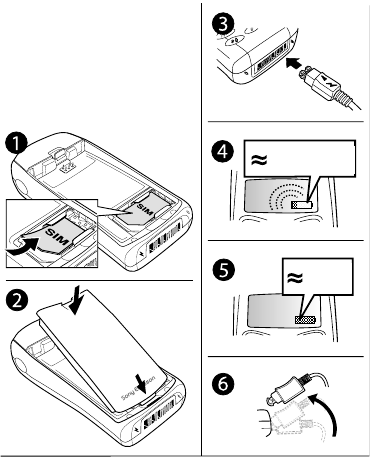
4 Getting started
SIM card and battery information
It may take up to 30 minutes before an icon
appears in the display when charging.
1. Insert the SIM card. Make sure the SIM card is placed
under the silvery holders.
2. Place the battery on the back of the phone and push
until you hear a click.
3. Connect the charger to the phone at the flash symbol.
The flash symbol on the charger plug must face
upwards.
4. It may take up to 30 minutes before the battery
charging icon appears in the display.
5. Wait approximately 4 hours or until the icon indicates
that the battery is fully charged. If you do not see the
battery icon after this time, press any key or the
joystick to activate the display.
6. Remove the charger by tilting the plug upwards.
You have to insert the SIM
card and charge the battery
before you can use the phone.
30 min.
4 h
.

Getting started 5
Making and receiving calls
To turn on the phone
• Press and hold NO until you hear a tone.
• Enter your PIN (Personal Identity Number), if you
have one for your SIM card.
Your PIN is provided by your network operator.
If you make a mistake while entering your PIN, delete
the wrong number by pressing .
If you enter the wrong PIN three times in a row, the
SIM card is blocked and the message PIN blocked
appears. To unblock it, you need to enter your PUK
(Personal Unblocking Key). Your PUK is provided by
your network operator.
To make and receive calls
• Enter the area code and phone number, and press YES
to make the call.
• Press NO to end the call.
• When the phone rings, press YES to answer the call.
On/off
My Network
12:18
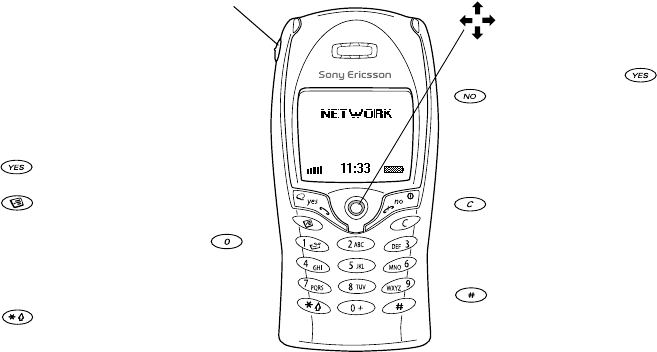
6 Getting to know your phone
Getting to know your phone
Key functions
Vo lu m e
key Increase or decrease the
volume of the earpiece during
a call. Scroll through menus,
lists and text. Enter the Status
menu in standby. Slide up or
down twice to reject an
incoming call. Slide up or
down once to turn off the ring
signal when receiving a call.
Make and answer calls. Select
a menu, submenu or an option.
Press for options.
1–9, 0 Enter the digits 0–9 and
letters. Press and hold to
enter the international prefix
+. Move through menus using
shortcuts.
Enter *. Shift between lower
and upper case.
Press the joystick up, down,
left or right to move through
the menus, lists and texts.
Press the joystick as an
alternative to .
Press and hold to turn the
phone on or off or to go back
to standby mode. Press to end
or reject a call, go back one
level in the menus or leave an
option unchanged.
(clear)
Delete numbers and letters
from the display. Delete an
item from a list. Press and
hold to turn off the
microphone during a call.
Enter #.
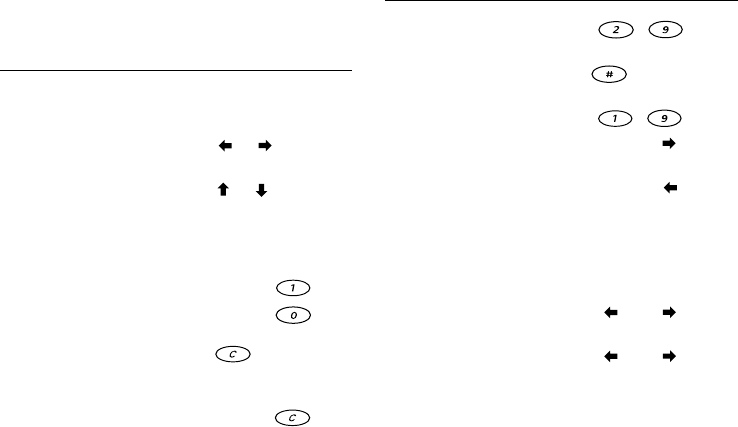
Getting to know your phone 7
Quick keys
The table describes some of the most useful key
combinations.
To... When in standby:
make an emergency call enter the international
emergency number and
press YES
enter and move through
the main menus press or
enter Call contact press or
enter the Call list press YES
voice dial press and hold YES or say
your magic word
call your Voice mail press and hold
enter the + sign to make an
international phone call press and hold
turn off the ring signal
when receiving a call press , or slide the
volume key up or down
once
set the phone to silent press and hold
reach a contact beginning
with a specific letter press and hold any of the
keys -
reach a phone number at a
specific position. press the position number
and
speed dial press any of the number
keys - and YES
find a contact in the Call
contact list press and hold
enter the first submenu of
the My shortcuts menu press and hold
see which profile you are
using slide the volume key up or
down
see today’s date slide the volume key up or
down
change the language to
Automatic press 8888
change the language to
English press 0000
To... When in standby:
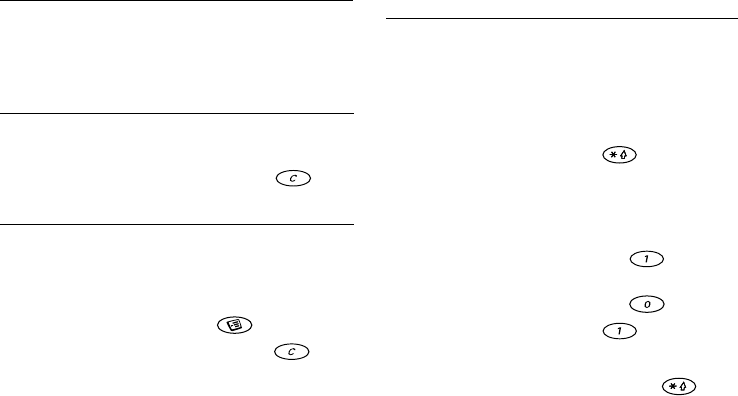
8 Getting to know your phone
reject a call quickly slide the volume
key up or down twice
when receiving a call or
press NO
To... During a call:
put a call on hold press YES
retrieve a call press YES again
turn off the microphone press and hold
To... When in the menus:
move through menus or
lists slide (and hold) the
volume key up or down or
use the joystick
select a menu or setting press YES
enter a quick options menu press
delete an item press and hold when
in lists
go back to standby press and hold NO
To... When in standby: To... When entering letters
using multitap text input:
reach the second letter or
character of a key slide the volume key up
and press any of the
number keys
reach the third letter or
character of a key slide the volume key down
and press any of the
number keys
shift between capital and
lower-case letters press , then the letter
enter numbers press and hold any of the
number keys
enter a question mark slide the volume key down
and press
enter the @-sign slide the volume key down
and press
enter a space press
delete letters and numbers press
shift between input
methods press and hold
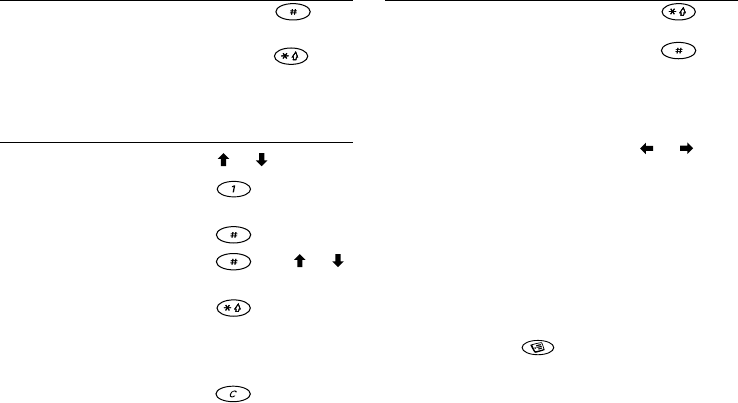
Getting to know your phone 9
Using shortcuts
A quicker way to move through the menus is to use
shortcuts. Enter the menus by pressing or and
then simply enter the number of the menu to which you
want to go. To get back to standby, press and hold NO.
You can quickly and easily reach the settings you
use most by placing them in the menu My shortcuts.
See “My shortcuts” on page 23.
Help texts
To help you use the menus and functions, your phone
has help texts that explain the menus.
• To get help, select the menu you want information
about and then press . Select Help, YES.
shift between input
languages
press and hold
enter a p (pause) press and hold when
saving codes
To... When entering letters
using T9 Text Input:
view alternative words press or
accept a word and add a
space press
enter a full stop press
view alternative
punctuation marks press , then
or
repeatedly
shift between capital and
lower-case letters press , then the letter
enter numbers press and hold any of the
number keys
delete letters and numbers press
To... When entering letters
using multitap text input:
shift between input
methods press and hold
shift between input
languages press and hold
To... When entering letters
using T9 Text Input:
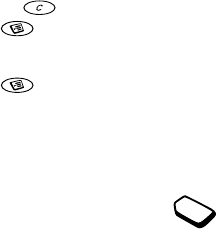
10 Getting to know your phone
Delete, edit and rename
If you add items, for example, a contact, a note, an
appointment or a WAP bookmark, it can be deleted,
edited or renamed.
There are two ways of deleting items:
• Select an item and press .
• Select an item, press , select Delete or Delete all.
There are two ways of editing items:
• Select an item, press , select Edit.
• Scroll to the item you want to edit and press YES twice,
select Edit.
Tip: You can rename an item in the same way.
Online services
Online services are customized services
offered by network operators, independently
of mobile phones and mobile phone
manufacturers.
A SIM card which supports Online services works
in the same way as a normal SIM card. When you have
inserted your SIM card and turned on your phone, your
network operator can download data to your SIM card.
After the first data download and after restarting your
phone, a new menu appears in your phone as the first
submenu under the Connect menu.
• To enter your new menu system, scroll to Connect/
Online services.
Note: This menu only appears if your SIM card
supports this service. Some operators may not use the
name “Online services”. Your phone may not support
all of the services offered.

Getting to know your phone 11
Menu overview
Phone book
Call contact
Find and send*
Add contact
Manage contact
Pictures
Personal rings
VoiceCommands
Special numbers
Advanced
Options
Messages
SMS
MMS
Call voice mail
E-mail
Chat
Area info
Options
Calls
Missed calls
Calling local
Call list
Manage calls
Time and cost
Next call
Options
Fun & Games
Themes
My pictures
Draw picture
My sounds
Composer
Sound recorder
Games
CommuniCam™
Settings
Sounds & alerts
Profiles
Display
Language
Time and date
Voice control
Locks
Handsfree
Master reset
Ongoing call *
Transfer sound
Record
Turn off tones
Hold call
Switch calls
Release active
Retrieve call
Join calls
Transfer call
Extract part
Release all
Release part
WAP services
Homepage
Bookmarks
Push inbox
Enter address
Resume
Select profile
Advanced
Options
Organizer
Calendar
Notes
Alarms
Timer
Stopwatch
Calculator
Code memo
Connect
Online services
Receive item
Infrared port
Bluetooth
Synchronization
GSM Networks
Data comm.
Accessories
My shortcuts
Select profile
Ring volume
Switch to line
My numbers
Edit shortcuts
Parties in conf.
Calls
* Only available during a call
Please note that some menus
are network- and subscription-
dependent.

12 Getting to know your phone
Entering letters
You can enter letters, for example, when you add
names to the phone book, write text messages or enter
WAP addresses.
Apart from the way you normally enter letters in
your phone, using multitap text input, you can use
T9™ Text Input for entering text messages and e-
mail, for example, if the input language you select
supports this. T9 Text Input is a predictive input
method and is a quicker way to write texts. See “T9™
Text Input” on page 13.
Input languages
Before you start entering letters, you need to select the
input languages that you want to use when writing.
To select input languages
1. Scroll to Settings, YES, Language, YES, Input, YES.
2. Scroll to the language that you want to use for entering
letters and press for each language you want.
3. Press YES to exit the menu.
When writing, you can switch to one of your selected
input languages by pressing and then selecting
Language. See “The list of options” on page 14.
Multitap text input
When saving names in the phone book or when writing
WAP addresses, you enter letters using multitap text
input. You press each key as many times as needed to
show the letter you want. In the following example, we
are going to write a name in the Phone book.
To enter letters using multitap text input
1. Scroll to Phone book, YES, Add contact, YES. Press YES
again.
2. Press the appropriate key, – , or
, repeatedly until the character you want appears
in the display.
See the table of the Latin alphabet below:
Press… to get…
Space - ? ! ‚ . : ; " ’ < = > ( ) _ 1
A B C Å Ä Æ à Ç 2 Γ
D E F è É 3 ∆ Φ
G H I ì 4
J K L 5 Λ
M N O Ñ Ö Ø ò 6
P Q R S ß 7 Π Σ
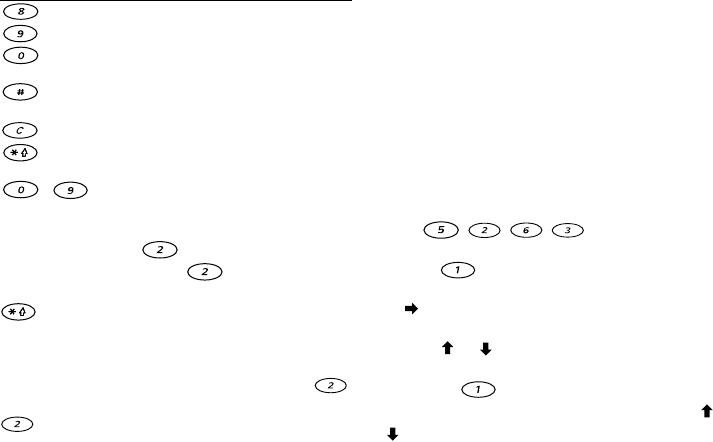
Getting to know your phone 13
Example:
• To enter an ‘A’, press once.
• To enter a ‘B’, quickly press twice.
• To shift between capital and lower-case letters, press
, then enter the letter.
Tip: You can also use the volume key as a shortcut to
certain letters:
To enter a ‘B’, slide the volume key up and press .
To enter a ‘C’, slide the volume key down and press
.
T9™ Text Input
You can use T9 Text Input when writing, for example,
text messages and e-mail. The T9 Text Input method
uses a built-in dictionary to recognize the most
commonly used word for each sequence of key
presses. This way, you press each key only once, even
if the letter you want is not the first letter on the key.
The following example shows how to start writing a
text message:
To enter letters using T9 Text Input
1. Scroll to Messages, YES, SMS, YES, Write new, YES.
2. For example, if you want to write the word “Jane”,
press , , , .
3. If the word shown is the one you want:
• press to accept and add a space.
(To accept a word without adding a space, press
.)
If the word shown is not the one you want:
• press or repeatedly to view alternative words
(candidates). Accept a word and add a space by
pressing .
If you do not find the word you want by pressing or
:
T U V Ü ù 8
W X Y Z 9
+ & @ / ¤ % $ € £ ¥ \ § ¿ ¡ 0 Θ Ξ Ψ
Ω
# * ↵ ¶
to delete letters and numbers
to shift between capital and lower-
case letters
- press and hold to enter numbers
Press… to get…
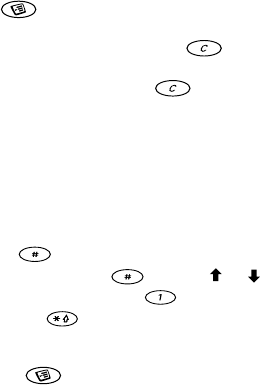
14 Getting to know your phone
• Press to go to a list of options.
• Select Edit word, YES.
• Delete the entire word by pressing , or delete
one letter at a time by pressing and holding the
joystick to the right, and then repeatedly.
• Write the new word using multitap text input and
press YES.
The word is added to the dictionary. The next time
you enter the word you just added to the dictionary,
it will appear as one of the alternative words.
4. Continue writing your message. See also “Sending text
messages” on page 50.
Tip: Press to enter a full stop. To enter other
punctuation marks, press and then or
repeatedly. Accept by pressing .
Press and hold to select an input method.
The list of options
If you press when writing, you enter a list of
options:
•Add symbol – Symbols and punctuation marks such as
? and , are shown. Move between the symbols by using
the joystick.
•Edit word – for T9 Text Input only
Edit the suggested word by using multitap text input.
•Rel. caps lock/Caps lock – Switch between capital and
lower-case letters.
•Language – Input languages that you selected earlier is
shown.
•Input method – A list of input methods available for
the current input language is shown.
•Candidates – for T9 Text Input only
A list of alternative words is shown.
•Accept word – for T9 Text Input only
Accept the suggested word.
•Help.
Turning off the T9 Text Input
If you wish, you can turn off the T9 Text Input. This
setting is valid for all input of texts – not only for the
text you are currently writing.
• To turn T9 Text Input on or off, scroll to Settings/
Language/Predictive.

Personalizing your phone 15
Personalizing your phone
You can adjust the phone settings to suit your own
requirements.
Note: If you change a setting which is included in a
profile, the active profile is also changed. See
“Profiles” on page 23.
Master reset
You can reset all the settings in the phone to the way
they were when you bought your phone by selecting
Reset settings.
If you also want to delete all contacts, messages and
other personal data, select Reset all instead.
Note: If you select Reset all, some pictures, melodies
and templates which came with your phone are
deleted.
To reset the phone
1. Scroll to Settings, YES, Master reset, YES.
2. Select Reset settings or Reset all, YES.
3. Enter the phone lock code (0000 or the new code if you
have changed it) and press YES.
Themes
You can change the appearance of the display, for
example, the colours and background picture, by using
themes. Your phone comes with some pre-set themes.
You cannot delete these, but you can create new
themes on Sony Ericsson Mobile Internet and
download them to your phone. For more information,
visit
www.SonyEricssonMobile.com/mobileinternet/.
• To select a theme, scroll to Fun & Games/Themes. If
you need to adjust the display contrast, scroll to
Settings/Display/Contrast.
To send a theme
You can exchange themes via IR, Bluetooth wireless
technology, MMS or e-mail. Please note that you are
not allowed to exchange copyright-protected material.
For more information on sending themes in messages,
see “Messaging” on page 49.
1. Scroll to Fun & Games, YES, Themes, YES.
2. Select a theme, press .
3. Select Send, YES.
4. Select a transfer method, YES.
If you use infrared make sure that the infrared ports are
facing each other.

16 Personalizing your phone
To receive and save a theme
1. From standby, press and scroll to Receive item,
YES.
Both the infrared port and the Bluetooth function are
activated for three minutes.
2. When you receive the theme, press YES to save it in
Themes.
Pictures
Your phone comes with a number of pictures. You can
• Have a picture as background when in standby mode.
• Assign a picture to a contact in the phone book. When
that person calls, the picture appears in the display
(provided your subscription supports the Calling Line
Identification service). See “To add a picture to a
phone book contact” on page 27.
• Enclose a picture in a text message.
All pictures are saved in My pictures, in the Fun &
Games menu.
You can also save animations in your phone. These
are handled like pictures.
Handling pictures
You can add, edit, or delete pictures in My pictures.
The number of pictures that can be saved depends on
the size of the pictures. File types supported are GIF,
JPEG and WBMP.
The pictures are shown in thumbnail view. To get a
full view, press YES.
To view your pictures
• Scroll to Fun & Games, YES, My pictures or
CommuniCam™, YES.
To select a picture as background
1. Scroll to Settings, YES, Display, YES, Background, YES.
2. Select Select picture, YES.
3. Select a picture, YES.
Tip: You can select a background by pressing
when viewing your pictures.
• To turn the background picture On or Off, scroll to
Settings/Display/Background/Activate
To edit and save a picture
1. Scroll to Fun & Games, YES, My pictures, YES.
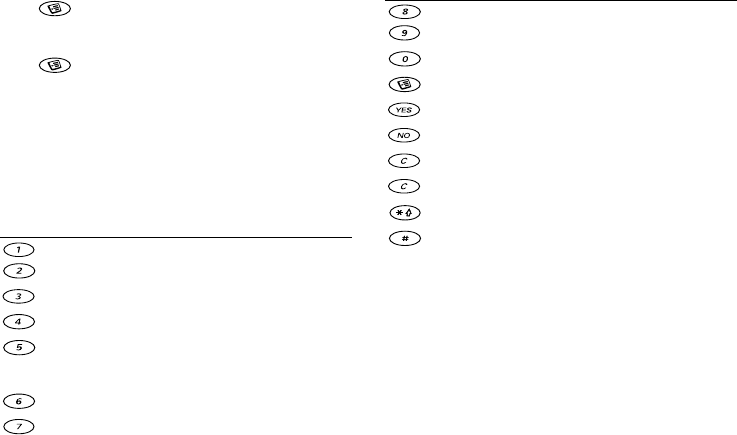
Personalizing your phone 17
2. Select a picture, YES.
3. Press , select Edit. You can now start to edit the
picture. You can only edit WBMP pictures. See the
table below.
4. Press , select Save, YES. The picture is saved in
My pictures.
To draw a picture
• To draw your own pictures, scroll to Fun & Games/
Draw picture.
When editing or drawing a picture:
Exchanging pictures
You can exchange pictures via IR, Bluetooth wireless
technology, MMS or e-mail. Please note that you are
not allowed to exchange copyright-protected material.
For more information on sending pictures in messages,
see “Messaging” on page 49.
Press… to…
move the cursor up and left.
move the cursor up.
move the cursor up and right.
move the cursor left.
lift up or put down the pen.
Press and hold to switch between zoom and
full size view.
move the cursor right.
move the cursor down and left.
move the cursor down.
move the cursor down and right.
move the cursor 1, 5 or 10 spaces.
view the Options menu.
save and exit the picture.
exit the picture editor.
undo the last action.
press and hold to clear the picture.
switch line thickness.
switch between black and white pen colour.
Press… to…

18 Personalizing your phone
Tip: Save a web album’s e-mail address in your phone
book and you can save pictures in that album if you
send the pictures as attachments.
To send a picture
1. Scroll to Fun & Games, YES, My pictures or
CommuniCam™, YES.
2. Select a picture, YES. Press .
3. Select Send, YES.
4. Select a transfer method.
If you use infrared make sure that the infrared ports are
facing each other.
To receive and save a picture
1. From standby, press and scroll to Receive item,
YES.
Both the infrared port and the Bluetooth function are
activated for three minutes.
2. When you receive the picture, press YES to save it in
My pictures.
• When you receive a picture via a text message or a
multimedia message, a new message appears in your
Inbox. To save the picture in My pictures, highlight the
picture, press and select Save.
Screen saver
The phone has a screen saver, which is activated
automatically when the phone has been in idle mode
for a few seconds. After a short period of time the
screen saver changes to sleep mode, to save power.
• To turn the screen saver On or Off, scroll to Settings/
Display/Screen saver/Activate.
To use a picture as the screen saver
You can select a picture, saved in the phone, and use it
as the screen saver.
1. Scroll to Settings, YES, Display, YES, Screen saver, YES.
2. Scroll to Select, YES.
3. Scroll to the picture you want to use as the screen
saver, YES.
4. Press YES to save.
Ring signals and melodies
Your phone comes with a number of ring signals and
melodies. You can edit your ring signals and melodies,
and send them to a friend, in a text message. It is also
possible to exchange melodies via WAP, Bluetooth
wireless technology, IR or cable. Please note that you
are not allowed to exchange copyright-protected
material.
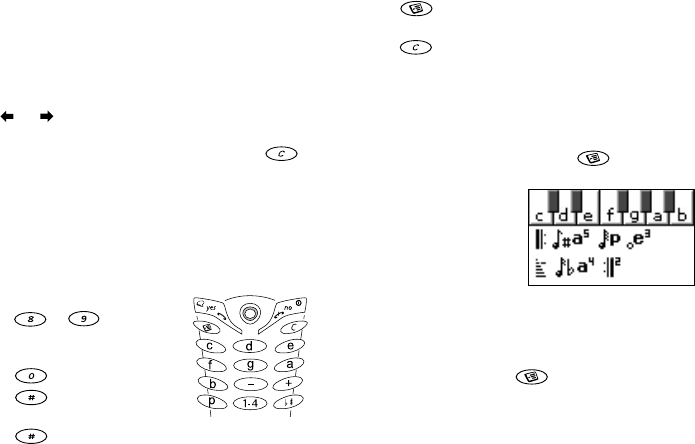
Personalizing your phone 19
• Select Ring signals from the Settings/Sounds & alerts
menu and select a ring signal.
To set the ring signal volume
1. Scroll to Settings, YES, Sounds & alerts, YES, Ring
volume, YES.
2. Press or to increase or decrease the volume.
3. Press YES to save the setting.
• To turn the ring signal on or off, press and hold
from standby and select Turn on silent or Turn off
silent.
All signals except the alarm and timer signals are
turned off.
To compose a ring signal or melody
1. Scroll to Fun & Games, YES, Composer, YES.
• Press a key to enter a note.
• Press or to make the
note shorter or longer. There are
six different lengths of notes.
• Press to change octave.
• Press once to raise the
note one semitone.
• Press twice to lower the note one semitone.
• Press to add a melody effect, and to set the
tempo, volume, style and duration.
• Press to remove notes.
2. To listen to your melody, press YES.
3. Press YES again to save and name it, or press NO to
continue composing.
Note: To edit a melody, scroll to Fun & Games/My
sounds, select the melody and press .
To use the piano
1. In the Composer, slide the
volume key up to activate
the piano.
2. Use the joystick to move
between the keys.
3. Press YES to select a note.
To send a melody
1. Scroll to Fun & Games, YES, My sounds, YES.
2. Select a melody and press .
3. Select Send, YES.
4. Select a transfer method.
If you use infrared make sure that the infrared ports are
facing each other.
See “Icons” on page 88.

20 Personalizing your phone
Note: To send a ring signal or melody in a text
message, see “To insert an item in a text message” on
page 50.
Receiving melodies
You can receive a sound or melody via IR, Bluetooth
wireless technology, SMS or MMS, or download it via
WAP. When you receive the sound or melody, press
YES to save it in My sounds.
If you use infrared make sure that the infrared ports
are facing each other.
Increasing ring
You can choose a ring signal that rises in steps from
the lowest volume to the highest.
• To turn increasing ring On or Off, scroll to Settings/
Sounds & alerts/Increasing ring.
Specific ring signals for personal calls
If you subscribe to the Two Line Service, you
can set different ring signals for the two voice
lines. Line 1 and Line 2 are displayed instead
of Voice calls.
If your subscription includes the Calling Line
Identification (CLI) service, you can assign a Personal
ring signal to up to ten callers.
To set a specific ring signal for a caller
1. Scroll to Phone book, YES, Personal rings, YES, Add
new?, YES.
2. Enter the first letter of the contact name, YES.
3. Select a contact, YES.
4. Select a ring signal, YES.
Sounds & alerts
You can choose to be notified of an incoming call by
the buzzing of the vibrating alert. You can set the
phone’s vibrating alert to one of the following:
•On – all the time.
•On if silent – on when the ring volume is turned off or
when you have set the phone to silent.
•Off – all the time.
To set the vibrating alert
1. Scroll to Settings, YES, Sounds & alerts, YES, Vibrating
alert, YES.
2. Select the setting you want, YES.

Personalizing your phone 21
From the Settings/Sounds & alerts menu, you can also
select Message alert, Key sound and turn on the
Minute minder.
If you turn on the minute minder, you hear a beep
once every minute during a call.
Menu language
Most SIM cards automatically set the menu language
to the language of the country where you bought your
SIM card. If this is not the case, the preset language is
English.
To change the menu language
1. Scroll to Settings, YES, Language, YES, Menus, YES.
2. Select a language, YES.
Note: You can always choose Automatic by pressing
8888 in standby.
You can always choose English by pressing 0000
in standby.
Display light
The display light can be set to automatic, off or on. In
automatic mode, the display light is turned off a few
seconds after you press the last key.
• To set the display light, scroll to Settings/Display/
Light.
• To set the display contrast, scroll to Settings/Display/
Contrast.
Time settings
The time is always displayed in standby.
• To set the time, scroll to Settings/Time and date/Set
time.
You can choose a 12-hour clock or a 24-hour clock.
• To set the time format, scroll to Settings/Time and
date/Time format.
If you select the 12-hour clock, you can alternate
between am and pm by pressing .
Date
When the phone is in standby mode, you can slide the
volume key up or down to see today’s date in the
Status menu.You can set the date and date format in the
Settings/Time and date menu.
Advanced time settings
Under Advanced in the Settings/Time and
date menu, you can set time zone and daylight

22 Personalizing your phone
saving time. Changing these, changes the time
accordingly.
When your phone changes network, and the time
sent out from the operator deviates from the time in
your phone, you are asked whether you want to update
the time if you have turned on Auto time zone. If you
press YES, the time is updated automatically.
Answering mode
When using a portable handsfree kit, you can choose to
answer a call by pressing any key (except the NO key)
or set the phone to answer the call automatically.
• To select answering mode, scroll to Settings/
Handsfree/Answering mode.
User greeting
When you turn your phone on or off, the Sony Ericsson
greeting appears in the display. Your operator’s own
greeting may be shown instead.
To select a greeting
1. Scroll to Settings, YES, Display, YES, User greeting,
YES.
2. Select a greeting, YES.
My phone numbers
You can check your own phone number(s).
• To check your phone number, scroll to Phone book/
Special numbers/My numbers. If your number is not
saved on your SIM card, you can enter it yourself.
Keypad lock
You can lock the keypad to avoid dialling a number by
accident.
Note: Calls to the international emergency number
112 can still be made, even when the keypad is locked.
Automatic keylock
Automatic keylock means the keypad is locked
25 seconds after you last press a key.
• To turn automatic keylock On or Off, scroll to Settings/
Locks/Auto keylock.
• To lock the keypad manually, press and hold in
standby, and select Turn on keylock.
The keypad remains locked until you answer an
incoming call or until you unlock the keypad manually.
• To unlock the keypad, press and hold and select
Turn off keylock?.

Personalizing your phone 23
My shortcuts
You can place your favourite functions that you want
to reach quickly and easily in the My shortcuts menu.
To add a function to my shortcuts
1. Scroll to My shortcuts, YES, Edit shortcuts, YES.
2. Select a function from the list by pressing .
3. Enter the position number you want for this function in
your menu and press YES.
4. Press YES to exit the list.
Profiles
Your phone has a number of pre-set profiles which are
set to suit a certain environment. You can add
accessories to, rename or change these profiles. For
example, when you go to a meeting, you can simply
choose the Meeting profile and a number of settings
such as the ring signal is turned off.
• To select a profile, scroll to Settings/Profiles/Select
profile.
To change a profile setting
1. Scroll to Settings, YES, Profiles, YES, Edit profile, YES.
2. Select a setting, YES.
3. Change the profile settings and press YES to confirm.
• To rename a profile, scroll to Settings/Profiles/Edit
profile/Profile name.
You can reset all profile settings to the way they were
set when you bought your phone.
• To reset all profiles, scroll to Settings/Profiles/Reset
profiles.
Automatic activation
Some profiles, for example In car, are automatically
activated when used with a specific accessory. When
disconnected, the profile is changed back.

24 Calling
Calling
Before you can make or receive any calls, you must
turn on the phone and be within range of a network.
See “Making and receiving calls” on page 5.
Making calls
1. Enter the area code and the phone number.
2. Press YES to make the call.
3. Press NO to end the call.
Tip: You can call numbers from the call list and the
phone book. See “Call list” on page 25 and “Phone
book” on page 26. You can also use your voice to make
calls. See “Voice control” on page 30.
To change the earpiece volume during a call
• Slide the volume key on the side of the phone up or
down to increase or decrease the earpiece volume
during a call.
To turn off the microphone during a call
• Press and hold until the display shows Muted.
Press and hold again to resume the conversation.
Automatic re-dialling
If the connection of the call failed and the display
shows Retry?, press YES. The phone re-dials the
number (up to ten times):
• until the call is connected.
• until you press a key or receive a call.
Note: Do not hold the phone to your ear while waiting.
When the call is connected, the phone gives a loud
signal.
Automatic re-dialling is not available for fax and data
calls.
Making international calls
1. Press and hold until a + sign appears in the
display.
The + replaces the international prefix number of the
country from which you are calling.
2. Enter the country, area code (without the leading zero)
and phone number, YES.
Making emergency calls
• Enter 112 (the international emergency number), YES.
Your phone supports the international emergency
numbers, 112, 911 and 08. This means that these
Calling 25
numbers can normally be used to make an emergency
call in any country, with or without a SIM card
inserted, if a GSM network is within range.
Note: Some network operators may require that a SIM
card is inserted, and in some cases that the PIN has
been entered as well.
In some countries, other emergency numbers may also
be promoted. Your operator may therefore have saved
additional local emergency numbers on the SIM card.
• To view your local emergency numbers, scroll to
Phone book/Special numbers/SOS numbers.
Receiving calls
When you receive a call, the phone rings and the
display shows Answer?.
If your subscription includes the Calling Line
Identification service and the caller’s number is
identified, the number is displayed. If you have saved
the number in the phone book, the name is displayed.
If you have assigned a picture to a contact, the picture
is displayed. If the number is a restricted number, the
display shows Withheld.
To answer a call
• Press YES.
To reject a call
• Press NO.
Tip: You can also use your voice to answer or reject
calls. See “Voice control” on page 30.
Missed calls
If you have missed a call, Missed calls:1 appears in
standby, indicating the number of missed calls.
To check your missed calls
1. Press YES to display the missed calls.
2. To call a number from the list, scroll to the number,
YES.
Call list
The numbers of the last calls that you have made are
saved in the call list. If your subscription includes the
Calling Line Identification service and the caller’s
number is identified, you will also find the numbers of
answered and missed calls in the call list.

26 Calling
To call a number from the call list
1. To enter the call list, press YES from standby.
2. Scroll to the number you want to call, YES.
• To clear the call list, scroll to Calls, YES, Options, YES,
Clear call list, YES.
• To turn the call list on or off, scroll to Calls, YES,
Options, YES, Call listing, YES.
Call priority service
You can request a certain priority when you
make a call, if your subscription supports the
call priority service.
The priority levels are defined by your operator and
are normally within the range of 0 – 4, where 0 is the
highest priority.
To check or change your standard priority level
1. Scroll to Calls, YES, Manage calls, YES, Default
priority, YES.
2. The network sends available priority levels.
3. Select a priority level, YES.
To change the priority for one call
1. Enter the phone number you want to call.
2. Scroll to Calls, YES, Next call, YES, Call priority,YES.
3. Select a priority, YES. The number is called.
Phone book
In the Phone book you can save all the information
needed to contact people. You can also set how much
information you want show for your contacts.
• To set the contact information, scroll to Phone book/
Options/Contact info.
To add a contact
1. Scroll to Phone book, YES, Add contact, YES.
2. Scroll to the field you want to fill in, press YES.
3. Enter the information, YES.
4. Select the next field and so on. To add more
information fields, press .
5. When you have entered the information, scroll to Save
and exit?, YES.
Tip: To enter an unsaved number, press when you
are in a number field, and select a number in the
unsaved numbers list.

Calling 27
Pictures, personal rings and voice commands
You can add a picture, personal ring signal and voice
command to a contact.
To add a picture to a phone book contact
1. Scroll to Phone book, YES, Pictures, YES.
2. Enter the first letters of the contact, YES.
3. When the contact is highlighted, press YES.
4. This takes you to My pictures. Select a picture and
press YES twice.
• Select Personal rings to add a personal ring signal.
• Select VoiceCommands to add a voice command.
To call a contact
1. From standby, press and hold one of the number keys
2-9 to find a contact beginning with the first letter on
that key (or closest following).
• For example, press and hold 5 to go to the first
contact beginning with “J”. To go to a contact
beginning with “L” press 5 three times after you
have entered the list of contacts.
2. When the contact you want to call is highlighted, press
YES.
3. Select the number you want to call, YES.
If only one number is linked to the contact, press
and hold YES at step 2.
Tip: You can also use the Call contact option in the
Phone book menu to call a contact.
Updating the phone book
When needed, you can easily update or delete any
contact information.
To edit a contact
1. Scroll to Phone book, YES, Manage contact, YES, Edit
contact, YES.
2. Enter the first letters of the contact, YES.
3. When the contact is highlighted, press YES.
4. Select Edit info., YES.
5. Scroll to the field you want to fill in, YES.
6. Enter the information, YES.
7. Select the next field and so on. To add more
information fields, press .
8. When you have entered the information, scroll down to
Save and exit?, YES.
28 Calling
• To delete a contact, scroll to Phone book/Manage
contact/Delete contact. Then select the contact and
press YES twice.
• To delete all contacts, scroll to Phone book/Advanced/
Delete all.
Note: Contacts that are saved on the SIM card are not
deleted.
Default (standard) number
Each contact has a default phone number. The first
phone number you link to a contact automatically
becomes the default number. If you scroll to a certain
contact in the Call contact list and then press and hold
YES, the default number is dialled.
To set the default number
1. Scroll to Phone book, YES, Manage contact, YES, Edit
contact, YES.
2. Enter the first letter of the contact, YES.
3. When the contact is highlighted, press YES.
4. Select Default number, YES. Select the number you
want as default, YES.
Groups
You can create a group of contacts. By doing so you
can send text messages to several recipients at the
same time. See “Sending text messages” on page 50.
To create a group of contacts
1. Scroll to Phone book, YES, Manage contact, YES,
Groups, YES, Add group, YES.
2. Enter a name for the group, YES.
3. Select Add member, YES.
4. Enter the first letters of the contact you want to add,
press YES.
5. Press YES to select the contact.
6. Select a phone number, press YES.
7. Repeat steps 3-6 to add more members.
Business cards
You can add your own business card to the phone
book.
• To add your own business card, scroll to Phone book/
Manage contact/My card. Then select Add.
Exchanging business cards
You can exchange business cards between your phone
and another similar phone, a PDA or a PC, using

Calling 29
Bluetooth wireless technology, the infrared port, an
SMS or MMS.
To send your business card
1. Scroll to Phone book, YES, Manage contact, YES, My
card, YES, Send, YES.
2. Select a transfer method, YES.
If you use infrared make sure that the infrared ports are
facing each other.
When you receive a business card via a text message,
you accept the card by pressing YES. To be able to
receive a business card using the infrared port or
Bluetooth wireless technology, you need to select the
Receive menu in order to activate the infrared port or
to make the phone discoverable.
To receive a business card
1. From standby, press and scroll to Receive item,
YES.
Both the infrared port and the Bluetooth function are
activated for three minutes.
2. When you receive the business card, press YES.
3. Press YES again to save the card in the phone book.
To send a contact
1. Scroll to Phone book, YES, Manage contact, YES, Send
contact, YES,
2. Enter the first letters of the contact you want to send,
YES.
3. Press YES to select the contact.
4. Select transfer method, YES.
If you use infrared make sure that the infrared ports are
facing each other.
• To send all contacts, scroll to Phone book/Advanced/
Send all and select a transfer method.
Copy contacts
You can copy the contacts between your phone’s
memory and the SIM card. The number of contacts
that can be saved depends on the type of SIM card.
• To copy contacts to the SIM card, scroll to Phone
book/Advanced/Copy all to SIM.
If you insert a SIM card with saved contacts in your
phone, you can call a contact by selecting Phone book/
Advanced/Call from SIM. If you want to edit a contact
saved on the SIM card, you first need to copy the
contact to the phone.

30 Calling
• To copy contacts to the phone, scroll to Phone book/
Advanced/Copy from SIM.
Tip: When you have selected a contact on the SIM
card in the Call from SIM menu, you can copy it to the
phone by pressing and then selecting Copy to
phone.
Speed dialling
You can save the phone numbers that you want to
reach easily in positions 1-9 on your SIM card.
To call any of these phone numbers from standby:
• Enter the position number and press YES.
To change position numbers
1. Scroll to Phone book, YES, Advanced, YES, Position
list, YES.
2. Select the phone number you want to move, YES.
3. Select the position to which you want to move the
phone number, press YES.
4. When you have finished press NO.
When prompted, press YES to confirm your changes.
Checking the memory
With the Memory status function in your phone book,
you can check how many positions you have left in
your memory.
• To check the phone book memory, scroll to Phone
book/Advanced/Memory status.
Voice control
With your phone, you can use your voice to:
• Voice dial – call someone by saying the name and
number type.
• Redial the last dialled number.
• Answer and reject calls when using a handsfree kit.
• Change profile.
• Record or listen to sound recordings by using voice
commands.
• Activate the voice control by saying a “magic word”.
You can save up to 100 voice commands. When
recording voice commands, make sure you are in a
quiet environment.
Before voice dialling
You must first turn on the name dialling function and
record your voice commands.
Calling 31
To turn voice dialling on and record number types
1. Scroll to Settings, YES, Voice control, YES, Voi ce
dialling, YES.
2. Select On, YES. Now you are going to record a voice
command for each number type you use with your
phone book contacts, for example, “home” or
“mobile”.
3. Instructions appear. Press YES.
4. Select a number type, YES.
5. Lift the phone to your ear, wait for the tone and say the
command that you want to record. The voice command
is played back to you.
6. If the recording sounds OK, press YES to save the voice
command. If not, press NO and repeat step 4.
7. Repeat steps 4 and 5 for each voice command you
need.
You also need to record voice commands for each
contact name, for example, “John”.
To record a voice command for a contact name
1. Scroll to Settings, YES, Voice control, YES, Voi ce
dialling, YES, Edit names, YES, Add voice, YES.
2. Select a contact, YES.
3. Follow the instructions in the display.
An icon appears next to a contact name which has a
voice command.
Caller name
You can choose whether you want to hear the recorded
contact name when you receive an incoming call from
that contact.
• To turn the caller name On or Off, scroll to Settings/
Voice control/Caller name.
Voice dialling
You can voice dial by saying the name of the contact.
To make a call
1. From standby, press and hold YES for one second.
2. Lift the phone to your ear, wait for the tone and say a
name, for example “John”. The name is played back to
you.
3. If you have several numbers for that contact, after a
second tone, say the number type, for example,
“home”.
The number type is played back to you, and the call is
connected.

32 Calling
From standby, you can also initiate voice dialling,
voice profiles and voice control of sound recordings
by:
• Sliding and holding the volume key.
• Pressing the handsfree button (when using a
portable handsfree or a Bluetooth headset).
• Saying the magic word. See “The magic word” on
page 34.
Redialling
You can use your voice to redial the last dialled
number, if you record a voice command for redialling.
To turn on and record a redial command
1. Scroll to Settings, YES, Voice control, YES, Voice redial,
YES.
2. Select On.
3. Instructions appear. Press YES.
4. Lift the phone to your ear, wait for the tone and say
“Redial”, or another word. If the recording sounds OK,
press YES. If not, press NO and repeat step 4.
To redial using a voice command
1. From standby, press and hold YES for one second.
2. Lift the phone to your ear, wait for the tone and say
“Redial”. The voice command is played back to you
and the last dialled number is redialled.
Voice answering
You can answer or reject incoming calls by using your
voice, when using a portable handsfree or a car
handsfree kit.
To turn on voice answering and record voice
answer commands
1. Scroll to Settings, YES, Voice control, YES, Voi ce
answer, YES.
2. Select On, YES.
3. Select the accessories you want to be able to use with
voice answering by pressing , YES.
4. Instructions appear. Press YES.
5. Lift the phone to your ear, wait for the tone and say
“Answer”, or another word. If the recording sounds
OK, press YES. If not, press NO and repeat step 5.
6. Say “Busy”, or another word. Press YES.
To answer a call using voice commands
• When the phone rings, say “Answer”.
The call is connected.
Calling 33
To reject a call using voice commands
• When the phone rings, say “Busy”.
The call is rejected. The caller hears a busy tone.
Changing profiles
If you record voice commands for your profiles, you
can change profile with your voice.
To turn on and record profile commands
1. Scroll to Settings, YES, Voice control, YES, Voi ce
profiles, YES.
2. Select On, YES.
3. Instructions appear. Press YES.
4. Select a profile, YES.
5. Lift the phone to your ear, wait for the tone and say the
profile name. Repeat steps 4 and 5 to record voice
commands for the other profiles.
To change a profile using voice commands
1. From standby, press and hold YES for one second.
2. Lift the phone to your ear, wait for the tone and say the
profile command for the required profile. The profile
command is played back to you and the current profile
is changed.
Sound recordings
Instead of using the menus, you can record voice
commands to start or to listen to a recording.
To turn on and record recording commands
1. Scroll to Settings, YES, Voice control, YES, Sound
recorder, YES.
2. Select On, YES.
3. Instructions appear. Press YES.
4. Lift the phone to your ear, wait for the tone and say
“Record”, then press YES.
5. Say “Play”, press YES.
To start a recording using a voice command
1. From standby, press and hold YES for one second.
2. Lift the phone to your ear, wait for the tone and say
“Record”. The voice command is played back to you
and a tone indicates that the recording has begun.
3. To end the recording, press YES.
To listen to recordings using a voice command
1. From standby, press and hold YES for one second.
2. Lift the phone to your ear, wait for the tone and say
“Play”. The voice command is played back to you.
3. Listen to your recordings. Press NO to stop.

34 Calling
The magic word
You can record a magic word and use it as a voice
command to allow totally handsfree access to voice
control. Instead of pressing and holding YES, you say
the magic word and then one of your recorded voice
commands. The magic word is especially suitable
when using a car handsfree kit.
Tip: Choose a long, unusual word which can easily be
distinguished from ordinary background speech.
To turn on and record the magic word
1. Scroll to Settings, YES, Voice control, YES, Magic word,
YES.
2. Select On, YES.
3. Select the accessories you want to be able to use with
the magic word by pressing , YES.
4. Instructions appear. Press YES twice.
5. Lift the phone to your ear, wait for the tone and say the
magic word.
Tip: Turn off the magic word when you no longer need
totally handsfree access, in order to save battery
power.
Editing your voice commands
You can keep all your voice commands up to date by
re-recording them or deleting the ones you do not use.
See the following example.
To re-record a voice command
1. Scroll to Settings, YES, Voice control, YES, Voi ce
profiles, YES, Edit commands, YES.
2. Select a voice command, YES.
3. Select Replace voice, YES.
To listen to a recorded voice command, select Play
voice.
4. Lift the phone to your ear, wait for the tone and say the
command.
You can also edit the voice command for a contact
name in Edit contact in the Phone book menu.
Tips when recording and using voice commands
If your phone cannot detect speech, one of the
following might have happened:
• You spoke too softly – try speaking more loudly.
• You held the phone too far away – hold it as you do
during a call.
• The voice command was too short – it should be
around one second long and more than one syllable.

Calling 35
• You spoke too late or too soon – speak immediately
after the tone.
• You did not record the voice command when the
handsfree was attached – for voice control with a
handsfree kit, record when the handsfree is attached.
• You used another intonation – use the same intonation
as you did when recording the voice command.
Voice mail
If your subscription includes an answering
service, callers can leave a voice mail
message when you cannot answer a call.
Receiving a voice mail message
Depending on your network operator, you are
informed that someone has left a message by a text
message (SMS) or by a voice mail indication. Press
YES to listen to the message.
Calling your voice mail service
You can easily call your voice mail service by pressing
and holding , if you have saved your voice mail
number in the phone. You get the number from your
service provider.
• To enter the number, scroll to Messages/Options/Voi ce
mail no.
Call time and cost
During a call, the duration of the call is shown
in the display. If you subscribe to cost
information, the call cost (or the number of
call units) is displayed.
You can check the duration of your last call, outgoing
calls and the total time.
• To check the call time, scroll to Calls/Time and cost/
Call timers and select an option. To reset the call time
meter, select Reset timers.
You can check the cost of your last call and the total
cost of your calls.
• To check the call cost, scroll to Calls/Time and cost/
Call costs and select an option. To reset the call cost
meter, select Clear total cost.
Note: If you subscribe to cost information, you must
enter your PIN2 to clear the cost or time counter.
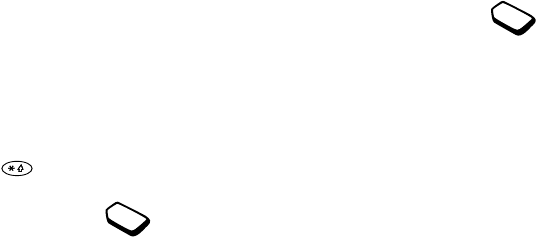
36 Calling
Setting the call cost
You can use the Tariff function to specify the price per
call unit. If you do not specify a price per call unit, the
number of call units is displayed.
To enter the price per call unit
1. Scroll to Calls, YES, Time and cost, YES, Call costs,
YES, Set tariff, YES.
2. Enter your PIN2, YES.
3. Select Change, YES.
4. Enter the code for the currency you want, (for example
GBP for Pounds Sterling), YES.
5. Enter the price per call unit, YES.
To enter a decimal point, press .
Credit limit for calls
You can enter a total amount of money that
can be used for making calls. When the
amount reaches zero, no more calls can be
made. Please note that the credit limit is only an
estimated value.
To set a credit limit
1. Scroll to Calls, YES, Time and cost, YES, Call costs,
YES, Set credit, YES.
2. Enter your PIN2, YES.
3. Select Change, YES.
4. Enter an amount, YES.
Diverting calls
If you cannot answer incoming voice, fax or
data calls, you can divert them to another
number, for example your answering service.
For voice calls, you can choose between the
following divert alternatives:
•Divert always – divert all voice calls.
•When busy – divert calls if you are already on the
phone.
•Not reachable – divert calls if your phone is turned
off or if you are unreachable.
•No reply – divert calls that you do not answer within
a specified time limit (operator-dependent).
Note: When the Restrict calls function is on, some
Divert calls options cannot be activated.
To turn on a call divert
1. Scroll to Calls, YES, Manage calls, YES, Divert calls,
YES.
2. Select a call category and then a divert alternative, YES.

Calling 37
3. Select Activate, YES.
4. Enter the phone number to which you want your calls
to be diverted and press YES, or retrieve it from the
phone book.
To turn off a call divert, select a divert option and
select Cancel.
To check status
• Scroll to Calls, YES, Manage calls, YES, Divert calls,
YES. Select a call type, YES. Scroll to the divert you
want to check, YES. Select Get status, YES.
• To check the status of all call diverts, select Check all
in the Divert calls menu.
More than one call
You can handle more than one call
simultaneously. For example, you can put an
ongoing call on hold, while you make or
answer a second call, and then switch between the two
calls.
Note: During a call the Ongoing call menu replaces
the Calls menu.
Call waiting service
If the call waiting service is activated, you hear a beep
in the earpiece if you receive a second call during an
ongoing call.
• To activate or deactivate the call waiting service, scroll
to Calls/Manage calls/Call waiting.
To make a second call
1. Press YES to put the ongoing call on hold.
2. Enter the number you want to call and press YES, or
retrieve a number from the phone book.
Note: You can only put one call on hold.
You can also reach the different options described
below by pressing .
Receiving a second call
• To answer the second call and put the ongoing call on
hold, press YES.
• To reject the second call and continue the ongoing call,
select Busy.
• Select Release&answer to answer the second call and
to end the ongoing call.
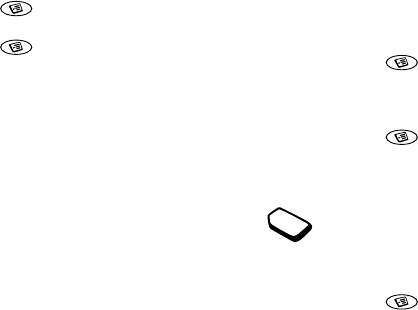
38 Calling
Handling two calls
When you have one ongoing call and one call on hold,
you can do the following:
• Press YES to switch between the two calls.
• Press , then select Join calls to join the two calls
into a conference call.
• Press , then select Transfer call, to connect the
two calls. You are disconnected from both calls.
• Press NO to end the ongoing call, then press YES to
retrieve the held call.
• Press NO twice to end both calls.
Note: You cannot answer a third call without ending
one of the first two calls.
Conference calls
In a conference call, you can have a joint
conversation with up to four other people.
You can also put a conference on hold and
make another call.
Creating a conference call
To create a conference call, you must first have one
ongoing call and one call on hold.
To join the two calls into a conference call
• Scroll to Ongoing call, YES, Join calls, YES.
To add a new participant
1. Press YES to put the conference call on hold.
2. Call the next person you wish to include in the
conference call.
3. Press , select Join calls, YES.
Repeat steps 1 to 3 to include more participants.
To release a participant
1. Press , select Release part, YES.
2. Select the participant, YES.
To end the conference call
• Press NO.
Having a private conversation
You can have a private conversation with one of the
participants and put the other participants on hold.
• Press , then select Extract part to select the
participant that you want to talk with.
• Select Join calls to resume the conference call, again.

Calling 39
Two voice lines
Your phone may have two voice lines with
different phone numbers. This may be useful
if, for example, you want to keep business
calls and private calls on separate lines.
• To select a line, scroll to Calls/Next call.
All outgoing calls are made on this line until you
change it. Incoming calls can still be received on either
line.
You can change the names of the lines, and have
different settings for each line, for example, different
ring signals.
• To change the name of a line, scroll to Settings/
Display/Edit line tags.
Calling card calls
You can use the calling card service to
redirect the cost of a call to a credit card or a
calling card account, instead of your normal
account. This may be useful, for example, when
making long distance calls.
You can save two separate calling card numbers.
The numbers and the codes associated with them are
protected by the code.
Before making a calling card call, you need to select
and activate a card.
Note: You cannot use the calling card service for fax
and data calls.
To turn the calling card service on or off
1. Scroll to Calls, YES, Time and cost, YES, Calling cards,
YES, Use callingcards, YES.
2. Enter your Phone Lock code, YES.
3. Select On or Off, YES.
To save a card number
1. Scroll to Calls, YES, Time and cost, YES, Calling cards,
YES, My cards, YES.
2. Enter your phone lock code, YES.
3. Select Add new?, YES.
Enter the card settings (the access number and name of
the calling card server, and the verification code). You
get this information from your card provider. Select
which you want to send first – the number that you
want to call, or the verification code. Press YES to
confirm your choice.

40 Calling
To select a card
1. Scroll to Calls, YES, Time and cost, YES, Calling cards,
YES, My cards, YES.
2. Enter your phone lock code, YES.
3. Select a card, YES.
4. Select Activate card, YES.
To make a calling card call
1. Enter the phone number of the person you want to call,
or retrieve the number from the phone book.
2. Press and hold YES.
The access number of the calling card server is called.
During the connecting phase, you are asked to send the
phone number you want to call and the verification
code.
3. Press YES when the display shows Send called
number?, or wait a few seconds and the number and
code are sent automatically.
Restricted dialling
You can use the restrict calls service to restrict
outgoing and incoming calls. This may be
useful, for example, when you are abroad. To
use this service, you need a password which you get
from your service provider.
Note: If you divert incoming calls, you cannot activate
some Restrict calls options.
The following calls can be restricted:
• All outgoing calls – All outgoing.
• All outgoing international calls – Outgoing intl.
• All outgoing international calls except to your home
country – Outg. intl roam.
• All incoming calls – All incoming.
• All incoming calls when you are abroad (when
roaming) – Inc when roam.
To turn a call restriction on or off
1. Scroll to Calls, YES, Manage calls, YES, Restrict calls,
YES.
2. Select an option, YES.
3. Select Activate or Cancel, YES.
4. Enter your password, YES.
• To turn off all call restrictions, select Cancel all.
• To change the password, select Change passwd.
Fixed dialling
The fixed dialling function allows calls to be
made only to certain numbers saved on the
SIM card. Fixed dialling requires a SIM card

Calling 41
that allows fixed numbers to be saved. The fixed
numbers are protected by your PIN2.
Note: Calls to the international emergency number
112 can still be made, even when the fixed dialling
function is on.
• Partial numbers can be saved. For example, saving
0123456 allows calls to be made to all numbers
starting with 0123456.
• Numbers with question marks can be saved. For
example, saving 01234567?0, allows calls to be made
to numbers from 0123456700 to 0123456790. To enter
a question mark, press and hold .
To turn fixed dialling on or off
1. Scroll to Phone book, YES, Options, YES, Fixed
dialling, YES.
2. Enter your PIN2, YES.
3. Select On or Off, YES.
• To save a fixed number, scroll to Phone book/Special
numbers/Fixed numbers. Select Add new? and enter
the number.
Closed user groups
The Closed User Group function is a way of lowering
call costs. On some networks it is cheaper to make
calls within a call group. You can save ten groups.
To add a group
1. Scroll to Calls, YES, Manage calls, YES, Closed groups,
YES, Edit list, YES.
2. Scroll to Add new?, YES.
3. Enter the name of the user group, YES.
4. Enter the index number, YES.
You get the index number from your operator.
To activate a group
1. Scroll to Calls, YES, Manage calls, YES, Closed groups,
YES, Edit list, YES.
2. Select a group, YES.
3. Select Activate,YES.
Calls can only be made within the selected group.
• To call outside a Closed User Group, select Open calls
and then select On.
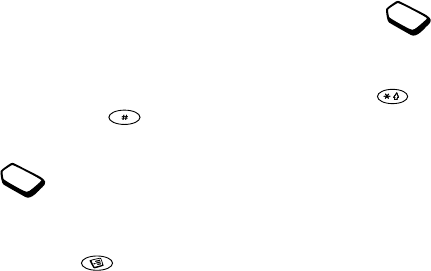
42 Calling
Accept calls
With the accept calls service, you can choose to
receive calls only from certain numbers. Other calls
are automatically rejected by a busy tone. The phone
numbers of calls you have rejected are saved in the
Call List.
To add numbers to the accepted callers list
1. Scroll to Calls, YES, Manage calls, YES, Accept calls,
YES, Accepted list, YES.
2. Scroll to Add new?, YES.
This takes you to the phone book.
3. Select an entry, YES.
• To select an accept option, scroll to Calls/Manage
calls/Accept calls/Accept options.
Networks
When you turn on the phone, it automatically
selects your home network if this is within
range. If it is not within range, you may use
another network, provided your network operator has
an agreement that allows you to do so. This is called
roaming.
You can select the network you want to use, or you
can add a network to your list of preferred networks.
You can also change the order in which networks are
selected during an automatic search. For all such
options, scroll to Connect, YES, GSM Networks, YES.
Additional calling functions
Tone signals
You can use telephone banking services or
control an answering machine by sending
tone signals (also known as DTMF tones or
touch tones) during a call.
• To send the tones, press the number keys 0-9,
and .
• To clear the display after the call is finished, press NO.
Notepad
You can use the phone to make a note of a phone
number during a call. When you press the number
keys, the person you are talking to hears tone signals.
To turn these tone signals off during the call, press
, select Turn off tones, YES. When you end the
call, the number remains in the display. You can then
call the number by pressing YES.

Setting up mobile Internet 43
Showing or hiding your number
If your subscription supports the Calling Line
Identification Restriction (CLIR) service, you
can hide your phone number when making a
call.
To show or hide your phone number
1. Enter the phone number you want to call.
2. Scroll to Calls, YES, Next call, YES.
3. Select Hide my number or Show my numb. and press
YES to make the call.
Setting up mobile Internet
In order to use the Internet, browse via WAP
services or send and receive e-mail messages,
you must have a phone subscription that
supports data transmission and settings
entered.
Note: Settings may already be entered when you buy
your phone, or you can receive settings from your
network operator or service provider. Settings are also
available at www.SonyEricssonMobile.com/
Receiving settings in a text message
Your GSM network operator or Internet service
provider may be able to send the required data account,
WAP and e-mail settings direct to your phone in a text
message (SMS).
To request settings from Sony Ericsson
1. Use a PC to go to
http://www.SonyEricssonMobile.com/. By using the
WAP and E-mail Configurator you can request that a
text message be sent to your phone with the settings
you need.

44 Setting up mobile Internet
2. When the message arrives, New settings received.
Install? appears.
•Press
YES to install the new settings
Note: If settings already exist in your phone you can
either keep or replace them. See “Advanced setting
information” on page 44 for more information.
•Press
NO to cancel installation. A new request for
settings is then required, as in step 1.
3. After installation, see “Using mobile Internet” on
page 57.
Set up with the wizard
If your phone is not set up for WAP, you can ask your
network operator or service provider to provide you
with WAP settings information. Then you can simply
use the wizard in your phone to help guide you through
the relevant settings.
To use the wizard for setting up WAP
1. Scroll to WAP services, YES, homepage (for example
Mobile Internet), YES. The wizard now starts if no
WAP settings exist.
2. Enter and save settings when asked, press YES to
confirm.
Advanced setting information
Mobile Internet, including WAP and e-mail, requires
the following settings:
•Data account – settings for access to a server for
WAP browsing and e-mail messaging.
•WAP profile – settings for WAP browsing.
•E-mail account – settings for e-mail messaging.
Data account settings
You can have several data accounts saved in
your phone, with different settings for
different purposes. The main setting for a data
account is the Account type (connection method).
Note: Please contact your network operator for
charging details.
You can choose from GPRS data or GSM data account
types.
GPRS (General Packet Radio Service) allows
fast and efficient access where you can
always be online.
Note: You need a subscription that supports GPRS.

Setting up mobile Internet 45
GPRS settings that are available:
•APN (Access point name address) – the address of
the external data network you want to connect to,
either an IP address or a text string.
•User id – your user id to log on to the external data
network.
•Password – your password to log on to the external
data network.
•Passwd request (Password request) – if this setting
is on, you are asked for a password each time you
log on to the external data network.
•Allow calls (Preferred service) – if you want to be
able to accept incoming calls during a GPRS
session, select Automatic. If not, select GPRS only.
•IP address – the IP address that the phone uses
when communicating with the network. If you do
not enter an address, the network provides you with
a temporary IP address.
•DNS address – if the network does not provide the
IP address to the DNS server automatically, you
may enter it here.
•Advan. settings (Advanced settings) – these are
optional. Consult your network operator.
GSM settings include some settings that are
similar to GPRS settings and some which are
GSM specific as follows:
•Phone number – the phone number of your
Internet service provider.
•Data rate – select the speed you want for the
connection.
•Dial type – select analogue or ISDN connection.
Note: If you want to change access type, you have to
create a new data account and select the access type
you want to use.
To create a data account manually
1. Scroll to Connect, YES, Data comm., YES, Data
accounts, YES, Add account?, YES.
2. Enter a name for the data account.
3. Select an access type.
4. Enter the settings that you have received from your
network operator or service provider.
Confirm each setting by pressing YES.
5. Scroll to Save?, YES.
46 Setting up mobile Internet
To edit a data account
1. Scroll to Connect, YES, Data comm., YES, Data
accounts, YES.
2. Select a data account, YES.
3. Select Edit.
4. Select the setting you want to edit, YES. Edit the
setting, YES.
5. Repeat step 4 for other settings you want to edit.
Preferred service
You can set GPRS or GSM as the preferred service.
• To select preferred mode, scroll to Connect/Data
comm./Pref. service and select GPRS and GSM or
GSM only.
Note: To see the status of GPRS coverage and
connection, slide the volume key up or down from
standby to enter the Status menu and then scroll to
GPRS.
WAP profile settings
The WAP settings are stored in a WAP profile. In most
cases you only need to use one profile to access the
Internet.
You set up and use additional WAP profiles, for
example, when accessing secure Internet sites, such as
a banking site or a corporate intranet. You then simply
switch between profiles when you need to change the
network connection.
To enter WAP profile settings manually
1. Make sure you have a data account set up between
your phone and the Internet server, as described in
“Data account settings” on page 44.
2. Scroll to WAP services, YES, Options, YES, WAP
profiles, YES.
3. Select Add profile? to add a new profile or select an
existing profile that you want to edit, YES.
• When selecting Add profile? enter a name for the
profile, YES, Connect using:, YES, select the data
account to be used, YES and enter the IP address:,
YES. A list appears in the display. Scroll to Save?,
YES.
• When selecting an existing profile, you can Edit,
Rename or Delete.
4. Select Edit and press YES.
5. You can now do the following:
•Chg homepage – Enter the address of the WAP site
you want as the homepage.

Setting up mobile Internet 47
•Connect using – Select data account.
•IP address – WAP gateway server address.
•User id – Enter your user id for the WAP gateway.
•Password – Enter your password for the WAP
gateway.
•Data mode – Select a data connection mode.
•Security – See WAP security settings.
•Show pictures – View pictures while browsing.
•Response timer – Set a time limit in seconds after
which a download attempt will stop.
WAP security settings
To establish secure connections when using certain
WAP services, you need to have certificates saved in
your phone. Your phone may already contain
certificates when you buy it. You can also download
certificates from certain WAP sites, or receive them
from a service provider.
To turn on a secure connection
1. Scroll to WAP services, YES, Options, YES, WAP
profiles, YES.
2. Select the profile you want to edit.
3. Select Edit, YES, Security, YES.
4. Select On, YES.
To check the certificates in your phone
1. Scroll to WAP services, YES, Options, YES, Common,
YES, Security, YES.
2. Select Trusted Certif. or Client Certif.
Locks (PIN codes)
PIN codes are used to protect your subscription from
unauthorized use, when accessing certain WAP sites,
and to authorize transactions. Your PIN code acts as a
signature when you confirm a transaction.
Note: These codes are supplied by your
network operator or service provider if
supported.
A Locks setting may appear in the Security
submenu:
• To go to the Locks menu, scroll to WAP services/
Options/Common/Security/Locks.
Transaction contracts
You can check which transactions you have made with
your phone when browsing. A contract, which contains
details about the transaction, can be saved in your
phone.
48 Setting up mobile Internet
• To check your contracts, scroll to WAP services/
Options/Common/Security/Contracts.
E-mail account settings
An e-mail account specifies, for example, the server
that is used for your e-mail messages.
To create an e-mail account
1. Scroll to Messages, YES, E-mail, YES, Options, YES.
2. Select Edit account, YES.
3. Select Add new?, YES.
4. Enter a name for the account, for example Home or
Office.
5. Select Connect using, YES.
A list appears with the data accounts that you have
saved in your phone.
6. Select the data account you want to use with this e-
mail account, YES.
7. Enter the rest of the settings in the list, some of which
are optional. To enter the settings, scroll to the setting,
press YES and enter the information. Press YES to
confirm. Repeat this for each required setting. You use
the same e-mail settings in your phone as in your PC e-
mail program. If you do not have an e-mail service,
contact your operator to get all the necessary settings.
•Protocol – select POP3 or IMAP4.
•Inc. server (Incoming server)– enter the name or IP
address of the service provider for incoming e-mail
messages. For example, mail.server.com or 10.1.1.1.
•Incoming port – if needed, change the number of the
port used by the protocol you are using.
•Mailbox – enter a user name for your e-mail account.
•Password – enter a password for your e-mail account.
•Outgoing server – enter the name or IP address of the
SMTP server to be able to send e-mail messages.
•Outgoing port – if needed, change the number of the
port used by the SMTP protocol.
•E-mail address – enter your e-mail address.
•From name – enter your name.
•Signature – select if you want to add your business
card to your e-mail messages.
•Copy outgoing – Select On, if you want e-mail
messages sent from your phone also to be sent to an e-
mail address of your choice. This way, your sent
messages are copied and can be saved for future
reference.
•Check interval – Select how often you want the phone
to connect to your e-mail server and check for
incoming e-mail messages.

Messaging 49
If you have both an office and a home e-mail account,
you can set one of them as default:
• Select Set account from the Messages/E-mail/Options
menu and select the account.
See “E-mail” on page 55 for information about how to
use e-mail.
Messaging
Your phone supports various messaging
services - text messages, chat messages,
multimedia messages and e-mail. Please
contact your service provider for details on
which services you can use.
Text messages
Text messages can be sent to one person, or to a group
of recipients that you have saved in the phone book
(see “Groups” on page 28). Text messages can also
contain pictures, animations, melodies and sounds.
Before you start
• First make sure that the number of your service centre
is set. The number is supplied by your service provider
and is usually saved on the SIM card.
To set the service centre number
1. Scroll to Messages, YES, SMS, YES, Options, YES,
Service centres, YES.
If the service centre number is saved on the SIM card it
appears in the display.
2. If there is no number in the list, select Add new?, YES.

50 Messaging
3. Enter the number, including the international “+” sign
and country code, YES.
Sending text messages
For information about entering letters, see “Entering
letters” on page 12.
To write and send a text message
1. Scroll to Messages, YES, SMS, YES, Write new, YES.
2. Write your message, YES.
3. Enter the recipient’s phone number, or retrieve a
number or a group from the phone book by pressing
.
4. Press YES to send the message.
Note: If you send a text message to a group, you are
charged for each member of that group.
To insert an item in a text message
1. Scroll to Messages, YES, SMS, YES, Write new, YES.
2. While writing your message press .
3. Select Insert item, YES.
4. Select Picture, Sound effect, Melody, Animation or My
anim. YES.
5. Select an item, YES. Then press YES again to confirm.
Text formatting
You can change the style, size and alignment of the
text, and create new paragraphs, in a text message.
To format the text in a text message
1. Scroll to Messages, YES, SMS, YES, Write new, YES.
2. Write the text message. Highlight the text you want to
format by sliding the volume key up while scrolling
with the joystick.
3. Press .
4. Select Text format, YES. Then select Text style, Text
size, Alignment or New paragr., YES.
5. Select a text format, YES.
Receiving text messages
When you receive a text message, the phone beeps and
the message New SMS Read now? appears in the
display. If you receive a text message from someone
you have saved as a contact in your phone book, the
name of that contact appears in the display along with
the text message.
To read the text message
Press YES to read the text message, or NO if you want to
read the message later. The message is saved in Inbox
Messaging 51
in the SMS menu. You may not receive all parts of a
long message at the same time.
While reading the text message you can, for example,
start a chat session with the sender or go to a WAP
address found in the text message.
When you have read the text message, press YES to
select one of the following options, for example,
Reply, Forward or Delete the text message. Press NO to
close the text message.
Saving incoming text messages
Incoming text messages are saved in the phone
memory. When the phone memory is full, incoming
text messages are saved on the SIM card. Messages
that you have saved on the SIM card remain there until
you delete them.
To save from a text message
When the phone number, WAP address, picture,
animation or melody is highlighted, press YES. Then
select to save the item and press YES.
• A picture or animation is saved in My pictures.
• A melody is saved in My sounds.
• A phone number is saved in Phone book.
• A WAP address is saved in Bookmarks.
Long messages
A text message can contain up to 160 characters. You
can send a longer message by linking two or more
messages. Please note that you are charged for the
number of linked messages.
• To turn long messages on, select Long SMS from the
Messages/SMS/Options menu, then select On.
Templates
If you have one or more messages that you send often,
you can save these as templates. Your service provider
may also have saved some templates in your phone.
To create a template
1. Scroll to Messages, YES, SMS, YES, Templates, YES,
Add new?, YES.
2. Write the message, YES.
3. Press YES if you want to send the message now. Press
NO to save the template.
Message options
You can set a default value for the message options
below, or you can turn on the Set on send option which

52 Messaging
means that you choose the settings each time you send
a message.
•SMS type – The phone supports different types of
messages. Your service provider may offer the facility
of converting a text message into a format (e-mail or
fax, for example) that suits the equipment that is going
to receive the message.
•Validity period – If your message cannot be delivered,
for example, if the recipient has turned off the phone,
your service centre can save the message to send it
later.
•Request reply – Include a reply request if you want the
recipient of your message to reply.
•Status request – Check if a message has been
delivered.
To set a default message option
1. Scroll to Messages, YES, SMS, YES, Options, YES.
2. Select a message option, YES.
3. Select an option, YES.
To turn set on send on or off
• Repeat steps 1 and 2 above, then select Set on send,
YES.
To check the status of a sent message
• Scroll to Messages, YES, SMS, YES, Sent items, YES,
select a text message, YES, View status, YES.
Mobile chat
The mobile chat function works in the same way as a
chat on the Internet. You can choose a nickname that
will appear in the recipient’s display each time you
send a chat message.
To enter a chat nickname
1. Scroll to Messages, YES, Chat, YES.
2. Select Nickname, YES.
3. Enter your nickname (maximum of 6 characters), YES.
To start a chat session
1. Scroll to Messages, YES, Chat, YES Start new, YES.
2. Enter the recipient’s phone number, or retrieve it from
the phone book by pressing .
3. Write your message, YES.
Receiving a chat session invitation
When you receive a chat session invitation, the phone
beeps and the message Chat Message Chat now?
appears in the display.
Messaging 53
• To read the chat message, press YES.
• Write your chat message reply and press YES.
• To suspend a chat session, press NO.
• To resume a chat session, scroll to Messages/Chat/
Resume.
• To end a chat session, press and hold NO.
• To reject a chat message, press NO. The rejected chat
message is saved in Inbox in the Messages menu.
If you receive a new chat message while another chat
session is ongoing, press YES to end the ongoing
session and start the new one.
Area information
Area information is a type of text message that is sent
to all subscribers in a certain network area, for
example, a local traffic report. When you receive an
area information message, the message automatically
appears in the display. You cannot save area messages.
Please consult your service provider for more
information about area information codes.
• To turn area information on or off, scroll to Messages/
Area info/Reception.
• To enter an area information code, scroll to Messages/
Area info/Message list/Add new?.
Cell information
The cell information channel is used by some network
operators to send messages to their subscribers within
a certain network area.
• To turn on the channel, scroll to Messages/Area info/
Cell information.
Multimedia Messages
Multimedia messages (MMS) can be sent to a mobile
phone and e-mail account. A multimedia message can
contain text, pictures and sounds. You can also send
contacts, calendar entries, sound recordings and notes
as attachments.
Before you start
Before sending a multimedia message, make sure that:
• The number to your service centre is set. To set the
service centre number, scroll to Messages/MMS/
Options/Message server.
• You have entered the WAP settings. Scroll to
Messages/MMS/Options/WAP profile and select Select

54 Messaging
or Create new. To create a WAP profile, see “To enter
WAP profile settings manually” on page 46.
Note: Your operator can automatically download all
the settings you need.
To compose and send a multimedia message
1. Scroll to Messages YES, MMS, YES, Write new, YES.
2. Select Blank,YES.
3. An icon appears, press YES to continue.
4. Select from the sub menus, press YES.
5. Enter the information you want to send, press YES.
Press YES again to continue.
6. Select Send message, YES.
7. Enter information as follows:
•To: – phone number or e-mail address. These can be
selected from the phone book.
•Subject: – write a title, YES.
8. Select Send message, YES.
Tip: Instead of selecting Blank, you can base your
message on one of the pre-defined templates.
Highlight a part of the message and press if you
are not satisfied and want to delete a part while
writing.
To edit the message before sending it
• To edit an item, select it and press YES.
• Text – Edit the existing text. To change text size,
select the text and press . Select Text size, YES.
• Pictures – Replace an existing picture with one from
My pictures.
• Sound – Replace an existing sound with an
alternative from My sounds.
• Timing – To set how many seconds you want an
item to be displayed, select the item and press .
Select Item timing, YES. To set the timing for the
page, select the cursor icon in the message, press
YES and select Page timing, YES.
Send options
Before sending a multimedia message you can set
different options.
• To edit an option, scroll to Messages/MMS/Options.
Receiving multimedia messages
When you receive a multimedia message, the phone
beeps and the message Read now? appears in the
display. Press YES to read the message.

Messaging 55
Note: Memory capacity is limited. You may have to
delete old messages before you can receive new ones.
Automatic download options
From the Messages/MMS/Options/Auto download
menu select one of the following:
•On – Your phone automatically downloads messages
to your phone as soon as they come to your operator’s
server. This is default.
•Confirm – Press YES to download or NO to keep it on
the server.
•Off – New messages appear in the inbox as icons.
Select the message and press YES to download.
To view a multimedia message
1. Press YES. The message is automatically played.
2. Press any key to stop.
When you have viewed a multimedia message you can
use the joystick to scroll through the message again.
When an item is highlighted, press to save it in
your phone.
When you have read the message, select Proceed to
select one of the following options: Reply, Forward or
Delete the message. Press NO to close the message.
Tip: You can select a message from the list of
messages and press to delete the entire message.
E-mail
You can use your phone to send and receive e-mail
messages. Please note that you need a subscription that
supports data transmission. For more information,
consult your service provider.
Before you start
First make sure that you have:
• Set up a data account. See “Data account settings” on
page 44.
• Set up and select an e-mail account. See “E-mail
account settings” on page 48.
Sending and receiving e-mail messages
The Send & receive option offers the fastest way to
send e-mail messages saved in the Outbox and check
for new e-mail messages.
To write and send an e-mail message
1. Scroll to Messages, YES, E-mail, YES, Write new, YES.
2. Select:

56 Messaging
•To: – then add name, enter an e-mail address, or
retrieve an e-mail address from the phone book. You
can also retrieve a saved address from received
messages in your inbox.
•Cc: – If you want to send a copy of the message to
someone.
•Priority: – Set the message priority.
•Subject: – Write a title, YES.
•Text: – Write your message, YES.
3. Select one of the following:
•Send now – The e-mail message is sent.
•Send w. attach. – You can attach a picture from My
pictures or from a digital camera connected via IR.
Select a picture and press YES to send.
•Save to outbox – The e-mail message is saved in the
Outbox.
•Save to drafts – The e-mail message is saved in the
Drafts folder
•Send & receive in the E-mail menu – All e-mail
messages in the Outbox are sent.
To receive and read e-mail messages
1. Scroll to Messages, YES, E-mail, YES, Send & receive,
YES.
2. When the e-mail messages have been downloaded to
the phone, scroll to Messages/E-mail/Inbox to read
them.
Note: The phone can save up to six complete e-mail
messages. All e-mail messages are also saved on your
e-mail server.
An arrow in the top or bottom left corner indicates that
there are more messages on the server. To retrieve
more messages, scroll to the arrow and press YES.
To reply to an e-mail message
1. Open the e-mail message.
2. Place the cursor in the text and press .
3. Select Reply or Reply all, YES.
4. Select Write new or Include this SMS to include the
message you received, press YES.
5. Write a message, YES.
To save an e-mail address or a phone number
1. When the e-mail address or phone number is
highlighted, press YES.
2. Select Save, YES.

Using mobile Internet 57
Archiving
You can archive an e-mail message in order to read it
later, or if you want to save important information. You
can archive only as much text as the display shows.
To archive an e-mail message
1. Open the e-mail message.
2. Make sure that the text you want to archive is visible in
the display.
3. Place the cursor in the text and press .
4. Select Copy to arch., YES. The text can be found in
Archive in the E-mail menu.
Using mobile Internet
Your phone has a WAP (Wireless Application
Protocol) browser and e-mail messaging
which are designed to bring a modified Internet to your
mobile phone. A wide range of services are available,
for example, news, entertainment, timetables,
reservations, banking, e-commerce, positioning and e-
mail.
Before you start
First make sure that you have:
• A phone subscription that supports data transmission.
• Correct settings in your phone for mobile Internet,
WAP and/or e-mail messaging. See “Setting up mobile
Internet” on page 43.
Note: See “E-mail account settings” on page 48 or
“E-mail” on page 55 for more information about e-
mail set-up and messaging.

58 Using mobile Internet
Using the WAP browser
To start browsing
1. First select the WAP profile you want to use. Scroll to
WAP services, YES, Select profile, YES.
2. Then select one of the following:
• Open your homepage (Sony Ericsson Mobile Internet
is default).
• Go to one of your bookmarks. Select Bookmarks, YES.
• Enter the address of a WAP site. Select Enter address,
YES, New address? to enter a new WAP address or
select one of the 10 latest entered addresses.
Tip: When you enter a WAP address, the normal
http:// prefix is not needed. You do however need to
enter a prefix to use protocols such as ftp:// or https://.
To exit WAP
• Press and hold NO to exit and disconnect or
• Press , select Exit WAP, YES.
•Press
YES again to remain connected and go to
standby, (or press NO to disconnect).
• Scroll to WAP services, YES, Resume to continue
browsing again.
Options when browsing
When you have started browsing, you can reach
different browsing options by pressing .
The options menu is dynamic. Its content may vary
depending on which WAP site you are visiting.
The options menu always contains the following:
• Go to the homepage set for the current WAP profile.
•Bookmarks – Add the site you are currently browsing
to your list of bookmarks, or see the list of bookmarks
for the current profile.
•Enter address – Enter the WAP address of a site you
want to visit.
•Save picture – Save a picture from the site.
•Send via SMS – Send a text message with a link to the
current WAP page to another phone.
•Send link – Send a link to the current site to another
phone via Bluetooth wireless technology or infrared.
•Reload – Refresh the contents of the WAP page.
•Exit WAP – Exit and go to standby or disconnect.
•Status – Display the current status, for example, how
long you have been browsing.
•Set as homepg – Set the current site as the homepage of
the WAP profile you are using.

Using mobile Internet 59
Using bookmarks
You use bookmarks in your mobile phone just as you
do with a PC Internet browser. You can have up to a
maximum of 25 bookmarks.
To work with bookmarks
1. Scroll to WAP services, YES.
2. Select the bookmark you want to work with, and press
.
3. Select one of the following options and press YES:
•Go to – Go to the marked WAP site.
•Edit – Edit the name and/or the WAP address of the
bookmark. See “Options when browsing” on
page 58 for more information.
•Delete – Delete the bookmark.
•Send via SMS – This creates a text message in which
the WAP address is sent as a link.
•Send – send as link to the current site.
•Set as homepg – set the current site as the
homepage.
WAP push messages
You can receive push messages via WAP Services.
This means that a service provider sends WAP content
to your phone without you having to do anything. You
can, for example, get updated news or new WAP
settings from your service provider.
There are two kinds of push messages:
• Text messages that inform you about WAP services, by
sending a link. To go to the WAP service, click the
link.
• Updated information from a WAP service is sent to
appear in the WAP browser.
Receiving a push message
You can set your phone to either accept or reject push
messages. This is valid for all your WAP profiles.
To set push message acceptance
1. Scroll to WAP services, YES, Options, YES, Common,
YES, Push access, YES.
2. Select one of the following settings:
•On – You allow push messages to be automatically
loaded.
•Prompt – You allow push messages but only when
you confirm.
•Off – You do not allow push messages.
60 Using mobile Internet
When you receive a push message, it comes to the
Push inbox where you can respond to it.
To respond to a push message
• Scroll to WAP services, YES, Push inbox, YES and select
one of the following:
•Postpone – Save the message, to be loaded later.
•Load – The browser starts and loads the WAP site so
that you can see the push content.
•Delete – Deletes the push message.
Stored information
The following information can be saved in your phone:
• Cache – Information which is regularly used to
improve frequent memory access.
• Passwords – Information for certain Internet server
access.
• Cookies – Information deposited fro m Internet servers
to improve frequent access.
To allow mobile Internet information in your phone
1. Scroll to WAP services, YES, Options, YES, Common,
YES.
2. Select the information to allow, YES.
Note: Check with your service provider for more
information regarding security certificates.
It is advisable to clear any sensitive information
about previously visited WAP services. This is to avoid
a security risk if your phone is misplaced, lost or
stolen.
To clear cache, password list, cookies or push
inbox
1. Scroll to WAP services, YES, Advanced, YES.
2. Select the information to be cleared.
3. Press YES to confirm.
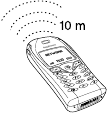
Transferring and exchanging information 61
Transferring and exchanging
information
Bluetooth™ wireless technology
Your phone has built-in Bluetooth wireless technology
which makes it possible for you to connect your phone
wirelessly to other Bluetooth devices such as a headset,
PC or other phones. You can, for example, have a
conversation via a cordless Bluetooth headset or
browse the Internet, wirelessly connected via a mobile
phone. You can automatically synchronize information
in your phone and your PC. You can also exchange, for
example, business cards, calendar items and pictures.
Note: We recommend that your
phone and the Bluetooth device you
are communicating with are within
a range of 10 metres. The
connection may be improved if
there are no solid objects in
between your phone and the other
Bluetooth device.
Before you start
To communicate with another Bluetooth device, you
first need to pair your phone with the device – you do
this by adding the device to a list of paired devices in
your phone. To synchronize with your PC, and to
browse the Internet, you also need to install software
on your PC from the Sony Ericsson Web site,
www.SonyEricssonMobile.com/support/. You can
exchange items or play games without having to pair
your phone with the other device.
Pairing
Pairing is the process of associating Bluetooth devices
with each other so that they can connect when they are
within range of each other. Your phone can be paired
with up to 10 Bluetooth devices. After pairing, the
operation mode of your phone is automatically set to
On. See “Operation modes” on page 62.
To initiate pairing with a device
1. Scroll to Connect, YES, Bluetooth, YES, Paired devices,
YES, Add device, YES, Phone initiates, YES.
A list of device types that can be paired with your
phone is shown. Scroll to a device type and press YES.

62 Transferring and exchanging information
2. The phone searches for Bluetooth devices. A list of
available devices of the type you selected then appears
in the display. Select a device, YES.
3. Enter a passkey (up to 16 digits) for the device, both in
the phone and, for example, in the PC. (If a passkey
does not come with the Bluetooth device when you buy
it, you need to create one yourself.)
4. When the pairing has been completed, you can edit the
name tag for the device and press YES.
To accept pairing with a device
• Scroll to Connect, YES, Bluetooth, YES, Paired devices,
YES, Add device, YES, Phone accepts, YES and wait for
the other device.
To organize your list of paired devices
• Scroll to Connect, YES, Bluetooth, YES, Paired devices,
YES. Then:
• To edit the name tag of a device: scroll to the device
you want to edit, YES, scroll to Edit, YES. Then edit
the name tag, YES.
• To delete a device from the list: scroll to the device
and press , YES.
• To change the order of the devices: scroll to the
device whose position you want to change, YES.
Select Edit order, YES. Then enter the position
number (2 - 10) you want for the device (position 1
is always for the headset).
Phone name
You can choose a name for your phone. This name is
shown in other devices when your phone is discovered,
and is also used for the infrared port.
• To enter a name, scroll to Connect/Bluetooth/Options/
Phone name/Edit.
Operation modes
The following operation modes are available:
•Off – the phone cannot send or receive any
information.
•Automatic – the Bluetooth function is turned on
automatically when you start sending information such
as a business card or when you answer or make a call
via the Bluetooth headset.
•On – the Bluetooth function is on all the time (until you
change the mode). Other paired Bluetooth devices can
initiate a connection to the phone. The phone has to be
in On mode when you use Voice dialling via a
Bluetooth headset or dial-up networking on a
computer.

Transferring and exchanging information 63
•Receive – the phone can always receive information
from any (paired or unpaired) Bluetooth device.
Note: In countries where the use of Bluetooth wireless
technology is not allowed, you must ensure that the
Bluetooth function is set to Off.
The Receive and On modes reduce the standby time
and talk time.
• To change the operation mode, scroll to Connect/
Bluetooth/Options/Operation mode.
In order for your phone to be detected by other
Bluetooth devices, to receive items from paired or
unpaired devices or to accept pairing, you must make
your phone discoverable.
To make the phone discoverable
• Scroll to Connect, YES, Bluetooth, YES, Discoverable,
YES. Your phone is discoverable for three minutes.
Searching for devices
You can search for Bluetooth devices and then, for
example, pair the device with your phone.
• To search for devices, scroll to Connect/Bluetooth/
Discover.
Sending and receiving
To send an item using Bluetooth wireless technology,
you need to make sure that the devices are within 10
metres of each other and that the operation mode is set
to Automatic, On or Receive.
To send an item
• After you select Bluetooth as the transfer method, the
phone searches for devices. A list of devices appears.
Select the device you want to send the item to and
press YES.
Tip: You can send certain items in your phone
(calendar overviews, appointments and tasks, business
cards, text messages) to specific Bluetooth printers.
Select the relevant printer in the list of devices.
To receive an item
1. From standby, press .
2. Scroll to Receive item, YES.
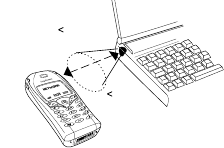
64 Transferring and exchanging information
For three minutes, the phone can now receive
information from any (paired or unpaired) Bluetooth
device.
Transferring the sound when using a headset
When you have paired a Bluetooth headset with your
phone, you can choose where the sound should be
transferred when making a call.
• Scroll to Connect/Bluetooth/Options/Headset sound.
Then select an option.
Light signals
• Steady blue light – the Bluetooth function is on and the
phone is charging.
• Blue light flashing slowly – the Bluetooth function is
either on, in receive mode, discoverable, or ready to
receive an item or a pairing request.
• Blue light flashing rapidly – Bluetooth communication
is in progress.
Infrared port
You can use the built-in infrared modem to establish
contact between your phone and a PC or another
device equipped with an infrared port.
Activate the infrared port
Before you can connect to another infrared device you
have to activate the infrared port in your phone.
• To activate the infrared port, scroll to Connect/Infrared
port.
To connect two devices
1. Place your phone as in the picture. The infrared port on
the phone must face the infrared port on the other
device.
Note: If you are connecting to a PC, make sure your
PC has activated infrared communication (Start/
Settings/Control Panel/Infrared/Options tab/Enable
infrared communication).
2. Your phone now establishes contact with the other
device.
3' 3"
1 m
30°
Transferring and exchanging information 65
Synchronization
You can synchronize the calendar and phone book in
your phone with similar programs in, for example, a
PC, PDA or mobile phone and with similar programs
on the Internet.
• To select which order first name and last name appear
in the phone when you synchronize contacts, scroll to
Phone book/Options/Sync. view.
Synchronization with nearby devices
After installing the synchronization program from the
Sony Ericsson Web site,
www.SonyEricssonMobile.com/support/, you can
synchronize your phone with your PC.
A status bar shows the progress of the
synchronization. If you use a cable, the
synchronization starts as soon as you connect the
cable. For more information, please refer to the
synchronization software online help.
Internet synchronization
You can synchronize your mobile phone contacts,
appointments and tasks with similar programs on the
Internet, using WAP. Contact your network operator
for more information about these programs on the
Internet and to receive user id, password and addresses
for the different programs. You must also have a WAP
profile set in your mobile phone. See “WAP profile
settings” on page 46.
To enter the WAP synchronization settings
1. Scroll to Connect, YES, Synchronization, YES, Options,
YES, Remote settings, YES.
2. Scroll to Remote login, YES.
3. Select WAP profile, YES.
Select the WAP profile you want to use for
synchronization.
4. Press NO. Select Sync. server, YES.
Enter the Internet address for the synchronization
server, and if required your user id and password.
5. Scroll to Save?, YES.
6. Press NO. Select Applications, YES.
7. Select a program, for example, Phone book, YES.
Enter the address for the program, in this case, the
phone book, and if required your user id and password.
8. Repeat step 6 for the other programs.
To start the WAP synchronization
1. Scroll to Connect, YES, Synchronization, YES, Remote
sync., YES, Applications, YES.

66 Transferring and exchanging information
2. Press to select the programs you want to
synchronize, YES.
3. Select Start, YES to start the synchronization.
Synchronization sound
The phone can make a sound when a synchronization
is completed or when a synchronization is initiated
from another device.
• To turn the synchronization sound on, scroll to
Connect/Synchronization/Options/Sound.
Fax and data calls
Send fax and data calls
To send fax messages and make data calls you
need to connect your phone to a computer, and then
start the appropriate software program.
Receive fax and data calls
The procedure of receiving fax messages and data calls
depends on your network and subscription. If you have
separate numbers for voice, fax and data calls, your
phone will recognize the type of call.
To receive a fax or data call (separate numbers)
1. Connect your phone to a computer.
2. Answer the call from within the software program (if it
does not answer automatically).
You cannot answer a fax or data call by pressing the
YES key on the phone.
One number
If you have a SIM card that does not support separate
fax and data numbers, the phone does not recognize
the type of incoming call.
If you want to receive a fax or data call, you have to
set the phone to one of these options. Once you have
set your phone for a specific incoming call, it stays like
this until you change it.
• To select the call type you want your next incoming
call to be, scroll to Calls/Next call/Next incoming.

More features 67
More features
Alarm clock
The alarm can be set to ring at a specific time within 24
hours, or recurrently at a specific time on several days.
You can have both these alarms set at the same time.
Even if you have set your phone to silent, the alarm
and timer signals ring. The alarm clock also rings if the
phone is turned off.
To set an alarm
1. Scroll to Organizer, YES, Alarms, YES, Alarm, YES.
2. Enter the time, YES.
• To change the alarm time, scroll to Organizer/Alarms/
Alarm/New time.
• Press any key to turn the alarm signal off when it rings.
If you do not want the alarm to be repeated, press YES.
• To cancel the alarm, scroll to Organizer/Alarms/
Alarm/Cancel.
• To set a recurrent alarm, scroll to Organizer/Alarms/
Recurrent alarm. Then enter the time and select the
days that you want the alarm to recur by scrolling and
pressing . Press
YES to exit the menu.
• To select an alarm signal, scroll to Settings/Sounds &
alerts/Alarm signal.
Stopwatch
Scroll to Organizer, YES, Stopwatch, YES.
• To start, stop or re-start the stopwatch, press YES.
• To save up to nine lap times, press .
• To check saved lap times, scroll using the joystick.
• To reset the stopwatch, press .
Note: The stopwatch is turned off when you answer an
incoming call or when you exit the stopwatch menu.
Timer
The phone has a built-in 24-hour timer.
• To set the timer, scroll to Organizer/Timer. When the
signal rings, press any key to turn it off.
Calculator
The phone has a built-in calculator, which can add,
subtract, divide and multiply.
• Press to get +, -, x, /.
• Press to delete the figure.
• Press to enter a decimal point.
68 More features
Code memo
Instead of having to remember all the different security
codes for credit cards, for example, you can save them
in the code memo in your phone. Then all you need to
remember is the password to open the code memo. You
can save a maximum of 10 codes in the code memo.
Checkword and security
To confirm that you have entered the correct password
for the code memo and to prevent unauthorized access
to your codes, you must enter a checkword. When you
enter your password to open the code memo, the
checkword is shown for a short time. If the password is
correct, the correct codes are shown. If you enter the
incorrect password, the checkword and the codes that
are shown are also incorrect.
Factors strengthening the security of the Code
memo function are:
• You get no feedback about whether the password is
correct, except for the checkword, and only you know
the checkword.
• All codes are encrypted in the mobile phone.
• When you access your codes, they are shown for a
limited time only.
To open code memo for the first time
1. Scroll to Organizer, YES, Code memo, YES.
A message with instructions appears.
2. Press YES.
3. Enter a four-digit password to open Code memo, YES.
4. Re-enter the new password to confirm.
5. Enter a checkword (maximum 15 characters), YES.
The checkword can consist of both letters and
numbers. To enter a number, press and hold the key.
To add a new code
1. Scroll to Organizer, YES, Code memo, YES.
2. Enter your password.
3. Select Add new code?, YES.
4. Enter a name associated with the code, for example,
the name of the credit card company, YES.
5. Enter the code, YES.
To open code memo
1. Scroll to Organizer, YES, Code memo, YES.
2. Enter your password, YES.
Your entered checkword appears. When the decryption
process has finished, your codes are shown.

More features 69
To change the password
1. Open code memo as described above.
2. Scroll to Options, YES, Chg password, YES.
3. Enter your new password, YES.
4. Re-enter the new password, YES.
5. Enter a checkword, YES.
Forgot your password?
If you forget your password, just enter any password to
access the Code memo function. The checkword and
codes that are then shown are incorrect. You must now
reset the Code memo.
To reset code memo
1. Scroll to Options, YES, Reset, YES.
2. Reset code memo? appears. Press YES.
The Code memo is reset and all entries are cleared.
The next time you enter the Code memo, you must
start at “To open code memo for the first time” on
page 68.
Calendar
You can use the calendar to keep track of important
meetings that you need to attend, phone calls that you
need to make or tasks that you need to do. The
calendar can be synchronized with a PC calendar or,
using WAP, with a calendar on the Web.
Appointments and tasks
You can save up to 300 appointments and 80 tasks in
your calendar, depending on the size of each item. You
can choose to add a new appointment or task, or to use
an old appointment or task as a template by copying
and editing it.
Tip: When you are in the list of appointments and tasks
for a certain day, you can use to edit, delete,
reschedule, send or copy. You can also call a number
included in a phone call task.
To add a new appointment
1. Scroll to Organizer, YES, Calendar, YES, Add
appointm., YES.
2. Enter the appropriate information, for example,
subject, location, icon and times. Confirm each entry
with YES.
3. If you want to set a reminder for your appointment,
select a reminder, YES.
70 More features
To add a new task
1. Scroll to Organizer, YES, Calendar, YES, Tasks, YES,
Add task?, YES.
2. Select a category, YES.
• If the category is a phone call, enter the phone
number, YES.
3. Enter a subject, YES.
4. If you want to set a reminder for your appointment,
select a reminder, YES.
Viewing your calendar
To view your calendar content, scroll to Organizer,
YES, Calendar, YES and then select one of the
following:
•View today – All appointments for today as well as
uncompleted tasks are shown.
•View week – Move within and among the days by
moving the joystick. Press YES to view a certain day.
•View month – Move within and among the days or
weeks by moving the joystick. Press YES to view a
certain day. Days on which you have appointments
are marked in bold.
Tip: In the monthly and weekly views, you can go to
next week by pressing 3, to next month by pressing 6
and to next year by pressing 9. You can go back a
week, a month or a year by pressing 1, 4, and 7
respectively. To reach the current day, press C.
Calendar settings
• Select Options from the Organizer/Calendar menu and
then select one of the options:
•View.
Starting day – Select a start day for the week.
Week display – Select 5-day week or 7-day week.
•Profile switch – If you want the phone to remind
you to switch profile when a meeting is about to
start, select Manual. If you want the profile to be
switched automatically, select Auto, then select a
profile.
•Reminders – Select Always if you want the reminder
to sound even though the phone is turned off.
Check the status
You can check how much space is left for new
appointments and tasks
• To check the status, scroll to Organizer/Calendar/
Advanced/Memory status.

More features 71
Tip: To delete all appointments and tasks in your
calendar, select Delete all in the Advanced menu.
Exchanging calendar entries
You can send and receive appointments and tasks using
Bluetooth wireless technology, the infrared port or
MMS.
To send an appointment or a task
1. In the list of appointments and tasks for a certain day,
scroll to the item you want to send and press .
2. Scroll to Send, YES.
3. Select a transfer method, YES.
If you use infrared make sure that the infrared ports are
facing each other.
To receive an appointment or a task
1. From standby, press and scroll to Receive item
YES.
Both the infrared port and the Bluetooth function are
activated for three minutes.
2. Add appointm.? or Add task? appears. Press YES to
save the appointment or task in your calendar.
If your calendar is full, you must remove calendar
items before you can save any new ones.
Find an appointment or task
You can search for appointments and tasks that contain
a specific text.
To search for appointments or tasks
1. Scroll to Organizer, YES, Calendar, YES, Advanced,
YES, Find, YES.
2. Select if you want to search for appointments or tasks
(if you have added any) by pressing , YES.
3. Enter the text you want to search for, YES.
Appointments or tasks that match your search are
shown. You can now view them by pressing YES, or
edit, delete, send or copy them by pressing .
Sound recorder
With the Sound recorder function, you can record
either your own memos or calls. All participants in the
call are automatically recorded. The recording is
terminated if any party hangs up.
The recordings are saved in your mobile phone and
can be accessed even if you change your SIM card.
Note: In some countries or states it is required by law
that you inform the other person before recording the
call.

72 More features
To start a sound recording
• Scroll to Fun & Games, YES, Sound recorder, YES,
Record, YES. Wait until you hear a tone. When the
recording starts, the display shows Recording together
with the time of the current recording (increasing).
To end the recording
• Press NO.
Tip: You can start recording or listening to recordings
with a voice command. See “Voice control” on
page 30.
The recording stops automatically if you receive an
incoming call or when the call ends. You hear a tone a
few seconds before the memory is full.
Listening to recordings
You can listen to your recordings at any time, even
during a call, and both persons will hear them.
To listen to your recordings
1. Scroll to Fun & Games, YES, Sound recorder, YES.
2. Scroll to the recording you wish to hear, YES
3. If you want to:
• Pause, press YES. Press YES again to play.
• Go to next or previous: move the joystick up or
down, respectively.
• Go fast forward or rewind: move and hold the
joystick right or left, respectively.
4. Press NO to stop playback.
To send a recording
1. Scroll to Fun & Games, YES, Sound recorder, YES.
2. Scroll to the recording you wish to send.
3. Press and select Send in MMS.
Tip: To see how many seconds you have left for
recording, press and scroll to “Remaining time”,
YES.
To erase or rename a sound recording
1. Scroll to Fun & Games, YES, Sound recorder, YES.
2. Press down to scroll to the recording you wish to erase
or rename.
3. Press when the recording is highlighted.
4. Select Erase or Rename, YES.
To erase all recordings
• Proceed as above, but select Erase all instead of Erase.

More features 73
Settings
You can choose to show the date/time or length of the
recording, or both.
To set the view of your recordings
1. Scroll to Fun & Games, YES, Sound recorder, YES.
2. Scroll to a recording. Press .
3. Select Set view, YES.
4. Select Date and time or Length, or both, YES.
Games
Your phone has several games. You can play some of
the games with another person, both using your phone,
or you can play on two phones, using Bluetooth
wireless technology or IR. Help texts are available in
each game.
To start a game
1. Scroll to Fun & Games, YES, Games, YES.
2. Select a game, YES.
3. Select New game or Resume game, YES.
4. Start the game.
How to control the games:
Use the joystick to move up, down, left or right and to
select an item, or use the keys as follows:
Notes
If you need to remember things, you can make a note
of it in your phone. You can add, edit, delete or send a
note. You can save 10 notes.
To add a note
1. Scroll to Organizer, YES, Notes, YES, Add note?, YES.
2. Enter the note, YES.
To view the notes
1. Scroll to Organizer, YES, Notes, YES.
2. A list, which shows the beginning of each note
appears.
• Select the note, that you want to view, YES.
= up = down
= left = right
= pause = select/deselect
= save and quit = confirm
= undo = reset

74 More features
Note: A note with an icon is a posted note, see “Post
note” on page 74.
Post note
You can display a note in standby mode.
To display a note in standby
1. Press and scroll to Post note, YES.
2. Select the note you want to display in standby or select
Add note? to write a new note, YES.
• If the note is long and you cannot see all of it, press
, Show note, YES.
• To turn off the note in standby, press , Hide note,
YES.
Exchanging notes
You can send and receive notes using Bluetooth
wireless technology, the infrared port or MMS.
To send a note
1. Select a note and press to display the list of
options.
2. Select Send, YES.
3. Select a transfer method, YES.
If you use infrared make sure that the infrared ports are
facing each other.
To receive a note
1. From standby, press and scroll to Receive item,
YES.
Both the infrared port and the Bluetooth function are
activated for three minutes.
2. Add note? appears. Press YES to save the note among
your other notes.

Security 75
Security
SIM card lock
The SIM card lock protects your subscription, but not
your phone itself, from unauthorized use. If you
change SIM cards, the phone still works with the new
SIM card.
Most SIM cards are locked at the time of purchase.
If the SIM card lock is on, you have to enter a “PIN”
(Personal Identity Number) every time you turn on
your phone.
If you enter your PIN incorrectly three times in a
row, the SIM card is blocked. This is indicated by the
message PIN blocked. To unblock it you need to enter
your “PUK” (Personal Unblocking Key). Your PIN
and PUK are supplied by your operator.
To unblock your SIM card
1. PIN blocked appears in the display.
2. Enter your PUK and press YES.
3. Enter a new four- to eight-digit PIN and press YES.
4. Re-enter the new PIN to confirm and press YES.
• To edit your PIN, scroll to Settings/Locks/SIM lock/
Change PIN.
Note: If the message “Codes do not match” appears,
you entered the new PIN incorrectly. If the message
“Wrong PIN” appears, followed by “Old PIN:”, you
entered your old PIN incorrectly.
• To edit your PIN2, scroll to Settings/Locks/SIM lock/
Change PIN2.
To turn the SIM card lock on or off
1. Scroll to Settings, YES, Locks, YES, SIM lock,
YES, Protection, YES.
2. Select On or Off, and press YES.
3. Enter your PIN and press YES.
Phone lock
The phone lock protects the phone against
unauthorized use if it is stolen and the SIM card is
exchanged. It is not on when you buy the phone. You
can change the phone lock code (0000) to any four- to
eight-digit personal code. The phone lock can be set to
on, automatic or off.

76 Troubleshooting
Phone lock on
If the phone lock is on, the message Phone locked
appears each time you turn on the phone. You have to
enter your code followed by YES to use your phone.
Automatic
If the phone lock is set to automatic, you do not need to
enter your phone lock code until a different SIM card
is inserted in the phone.
• To edit your phone lock code, scroll to Settings/Locks/
Phone lock/Change code.
Note: It is important that you remember your new
code. If you should forget it, you have to hand in your
phone to your local Sony Ericsson retailer.
To set the phone lock
1. Scroll to Settings, YES, Locks, YES, Phone lock, YES,
Protection, YES.
2. Select an alternative and press YES.
3. Enter the phone lock code and press YES.
Troubleshooting
This chapter lists some problems that you might
encounter while using your phone. Some problems
require that you call your service provider, but most of
the problems you can easily correct yourself.
The phone cannot be switched on
Hand-held phone
Recharge or replace the battery. See “SIM card and
battery information” on page 4.
No indication of charging
When you start charging a battery that is empty or a
battery that has not been used for a long time, it may
take up to 30 minutes before the battery icon appears in
the display.
Menu language
If the display shows a language that you do not
understand, you can always choose Automatic
(determined by your SIM card) by pressing 8888
in standby. You can always choose English by
pressing 0000 in standby.

Troubleshooting 77
Grey menu options
Grey text indicates a function that is
temporarily unavailable, for example due to
your subscription or due to a certain setting
which has not been turned on.
Since you cannot send themes, pictures and sounds
that are copyright-protected, the Send menu is
sometimes unavailable.
Error messages
Insert SIM
There is no SIM card in the phone or you may have
inserted it incorrectly. Insert a SIM card. See “SIM
card and battery information” on page 4.
Insert correct SIM card
The phone is set to work only with certain SIM cards.
Insert the correct SIM card.
SOS calls only
You are within range of a network, but you are not
allowed to use it. However, in an emergency, some
operators allow you to call the international emergency
number 112. See “Making emergency calls” on
page 24.
No network
There is no network within range or the received signal
is too weak. You have to move to get a signal that is
strong enough.
Wrong PIN/Wrong PIN2
You have entered your PIN or PIN2 incorrectly.
• Enter the correct PIN or PIN2, and press YES. See
“SIM card lock” on page 75.
Codes do not match
When you want to change a security code (for example
your PIN) you have to confirm the new code by
entering it again. The two codes that you have entered
do not match. See “SIM card lock” on page 75.
PIN blocked/PIN2 blocked
You have entered your PIN or PIN2 incorrectly three
times in a row. To unblock, see “SIM card lock” on
page 75.
78 Additional information
PUK blocked – contact operator
You entered your personal unblocking key code (PUK)
incorrectly 10 times in a row. Contact your network
operator or service provider.
Phone locked
The phone is locked. To unlock the phone, see “Phone
lock” on page 75.
Phone lock code:
Your phone comes with the phone lock code, 0000.
You can change it to any four- to eight-digit code. See
“Phone lock” on page 75.
Number not permitted
The Fixed Dialling function is on and the number you
have dialled is not on your fixed numbers list. See
“Fixed dialling” on page 40.
Charging, alien battery
The battery you are using is not an Sony Ericsson-
approved battery and is charging slowly for safety
reasons.
Additional information
Sony Ericsson Consumer web site
On www.SonyEricssonMobile.com/support/ you will
find a support section where help and tips are only a
few clicks away. Here you find the latest software
updates, tips on how to use your product more
efficiently, function guides for some of the products
and additional help when you require it.
Additional information 79
Guidelines for Safe and Efficient Use
Please read this information before using your mobile
phone.
PRODUCT CARE AND MAINTENANCE
•Do not expose your product to liquid or moisture or to
humidity.
•Do not expose your product to extreme high or low
temperatures.
•Do not expose your product to lit candles, cigarettes, or
cigars, or to open flames etc.
•Do not drop, throw or try to bend your product as rough
treatment could damage it.
•Do not paint your product as the paint could obstruct the
earpiece, microphone or any moveable parts and prevent
normal use.
•Do not attempt to disassemble your product. Your
product does not contain consumer serviceable
components. Only Sony Ericsson authorised personnel
should perform service.
•Do not use any accessories other than Ericsson or Sony
Ericsson branded originals intended for use with your
product (herinafter referred to as “original accessories”).
Use of non-original accessories may result in loss of
performance, damage to the product, fire, electric shock
or injury. The warranty does not cover product failures
which have been caused by use of non-original
accessories.
•Treat your product with care, keep it in a clean and
dust-free place.
ANTENNA CARE
Your mobile phone is equipped with an internal antenna.
• To avoid impaired performance, please ensure that your
mobile phone’s antenna is not damaged.
• Do not remove the antenna yourself.
• Only use an antenna that has been specifically designed
by Sony Ericsson for your mobile phone. Use of
unauthorised or modified antennas could damage your
mobile phone and may violate the appropriate
regulations, causing loss of performance and SAR levels
above the recommended limits (see below).
EFFICIENT USE
For optimum performance with minimum power
consumption please:
• Hold your mobile phone as you would any other
telephone. While speaking directly into the mouthpiece,
angle the antenna in a direction up and over your
shoulder.
• Do not touch the antenna when the mobile phone is in
use. Touching the antenna affects call quality, may cause
the mobile phone to operate at a higher power level than
needed and may shorten talk and standby times.
• If your mobile phone is equipped with infrared, never
direct the infrared ray at anyone’s eye and make sure
that it does not disturb any other infrared units.
80 Additional information
RADIO FREQUENCY (RF) EXPOSURE AND
SAR
Your mobile phone is a low-power radio transmitter and
receiver. When it is turned on, it emits low levels of radio
frequency energy (also known as radio waves or radio
frequency fields).
Governments around the world have adopted
comprehensive international safety guidelines,
developed by scientific organizations*, e.g. ICNIRP
(International Commission on Non-Ionizing Radiation
Protection), through periodic and thorough evaluation of
scientific studies. These guidelines establish permitted
levels of radio wave exposure for the general population.
All Sony Ericsson mobile phone models are designed to
operate within these stringent levels. The levels include a
safety margin designed to assure the safety of all
persons, regardless of age and health, and to account for
any variations in measurements.
Accessories can significantly affect a mobile phone’s
compliance with the radio frequency exposure
guidelines. To avoid causing loss of performance or radio
frequency exposure levels above the permissible limits it
is recommended that you only use Sony Ericsson or
Ericsson original accessories intended for use with the
mobile phone. If you wear the mobile phone on your
body while it is transmitting, and you do not use a Sony
Ericsson or Ericsson original body worn accessory,
please ensure that the mobile phone is positioned a
minimum of 1.5 cm from your body and that you are not
using an accessory that contains any metal.
Specific Absorption Rate (SAR) is the unit of
measurement for the amount of radio frequency energy
absorbed by the body when using a mobile phone. The
SAR value is determined at the highest certified power
level in laboratory conditions, but the actual SAR level of
the mobile phone while operating can be well below this
value.
This is because the mobile phone is designed to use
the minimum power required to reach the network.
Therefore, the closer you are to a base station, the more
likely it is that the actual SAR level will decrease.
Variations in SAR below the radio frequency exposure
guidelines do not mean that there are variations in safety.
While there may be differences in SAR levels among
mobile phone models, all mobile phone models must be
designed to meet radio frequency exposure guidelines.
A separate leaflet with SAR information for this mobile
phone model is included with the material that comes
with this mobile phone. This information is also available
on www.SonyEricssonMobile.com/.
More information on radio frequency exposure and
SAR can be found on: www.SonyEricssonMobile.com/.
* Examples of radio-frequency exposure guidelines
and standards that Sony Ericsson mobile phone models
are designed to conform to:
• International Commission on Non-Ionizing Radiation
Protection (ICNIRP), “Guidelines for limiting exposure to
Additional information 81
time-varying electric, magnetic, and electromagnetic
fields (up to 300 GHz)”, Health Physics, vol. 74, pp 494-
522, April 1998.
• 99/519/EC, “Council Recommendation of 12 July 1999
on the limitation of exposure of the general public to
electromagnetic fields (0 Hz to 300 GHz)”, Official
Journal of the European Communities, 1999.
• IEEE C95.1-1991, “Safety levels with respect to human
exposure to radio frequency electromagnetic fields, 3
kHz to 300 GHz”, The Institute of Electrical and
Electronics Engineers Inc. (IEEE).
• FCC Report and Order, ET Docket 93-62, FCC 96-326,
Federal Communications Commission (FCC), August
1996.
• Radiocommunications (Electromagnetic Radiation
Human Exposure) Standard 1999, Australian
Communications Authority (ACA), May 1999.
• Health Canada Safety Code 6, 1999 "Limits of Human
Exposure to Radiofrequency Electromagnetic Fields in
the Frequency Range from 3 kHz to 300 GHz".
DRIVING
Please check if local laws and/or regulations, in the
country/state where you are, restrict the use of mobile
phones while driving. Law in many countries/states
requires drivers to use a Hands Free solution. Sony
Ericsson recommends that you use Ericsson or Sony
Ericsson Hands Free solutions intended for use with your
mobile phone only.
Always give full attention to driving and pull off the
road and park before making or answering a call if driving
conditions so require.
RF energy may affect some electronic systems in
motor vehicles such as car stereo, safety equipment etc.
In addition, some vehicle manufacturers do not allow use
of mobile phones in their vehicles, unless a Hands Free
kit with an external antenna supports the installation.
Check with your vehicle manufacturer’s representative to
be sure that your mobile phone will not affect the
electronic systems in your vehicle.
Vehicles Equipped with an Air Bag
An air bag inflates with great force. Do not place objects,
including either installed or portable wireless equipment,
in the area over the air bag or in the air bag deployment
area. If in-vehicle wireless equipment is improperly
installed and the air bag inflates, serious injury could
result.
ELECTRONIC DEVICES
Most modern electronic equipment, for example
equipment in hospitals and cars, is shielded from RF
energy. However, certain electronic equipment is not,
therefore:
• Do not use your mobile phone near medical equipment
without requesting permission.
82 Additional information
Mobile phones may affect the operation of some
implanted cardiac pacemakers and other medically
implanted equipment. Pacemaker patients should be
aware that the use of a mobile phone very close to a
pacemaker might cause the device to malfunction. Avoid
placing the mobile phone over the pacemaker, e.g. in
your breast pocket. When using the mobile phone, place
it at the ear opposite the pacemaker. If a minimum
distance of 15 cm (6’’ inches) is kept between the mobile
phone and the pacemaker, the risk of interference is
limited. If you have any reason to suspect that
interference is taking place, immediately turn off your
mobile phone. Contact your cardiologist for more
information.
If you use any other personal medical device, consult
the manufacturer of your device to determine if it is
adequately shielded from external RF energy.
Turn your mobile phone off in any facility where posted
notices so require.
AIRCRAFT
• Turn off your mobile phone before boarding any aircraft.
• To prevent interference with communication systems,
you must not use your mobile phone while the plane is in
the air.
• Do not use it on the ground without permission from the
crew.
BLASTING AREAS
• Turn off your mobile phone when in a blasting area or in
areas posted “turn off two-way radio” to avoid interfering
with blasting operations. Construction crews often use
remote control RF devices to set off explosives.
EXPLOSIVE ATMOSPHERES
Turn off your mobile phone when in any area with a
potentially explosive atmosphere. It is rare, but your
mobile phone or its accessories could generate sparks.
Sparks in such areas could cause an explosion or fire
resulting in bodily injury or even death.
Areas with a potentially explosive atmosphere are
often, but not always, clearly marked. They include
fuelling areas, below deck on boats, fuel or chemical
transfer or storage facilities, and areas where the air
contains chemicals or particles, such as grain, dust, or
metal powders.
Do not transport or store flammable gas, liquid, or
explosives in the same compartment of your vehicle that
contains your mobile phone and accessories.
POWER SUPPLY
• Connect the AC power adapter only to designated power
sources as marked on the product.
• To reduce risk of damage to the electric cord, remove it
from the outlet by holding onto the AC adapter rather
than the cord.
Additional information 83
• Make sure the cord is positioned so that it will not be
stepped on, tripped over or otherwise subjected to
damage or stress.
• To reduce risk of electric shock, unplug the unit from any
power source before attempting to clean it.
• The AC power adapter must not be used outdoors or in
damp areas.
• DANGER – Never alter the AC cord or plug. If the plug
will not fit into the outlet, have a proper outlet installed by
a qualified electrician. Improper connection can result in
risk of electric shock.
CHILDREN
DO NOT ALLOW CHILDREN TO PLAY WITH YOUR
MOBILE PHONE OR ITS ACCESSORIES. THEY
COULD HURT THEMSELVES OR OTHERS, OR
COULD ACCIDENTALLY DAMAGE THE MOBILE
PHONE OR ACCESSORY. YOUR MOBILE PHONE OR
ITS ACCESSORY MAY CONTAIN SMALL PARTS THAT
COULD BE DETACHED AND CREATE A CHOKING
HAZARD.
DISPOSING OF THE PRODUCT
Your mobile phone should not be placed in municipal
waste. Please check local regulations for disposal of
electronic products.
EMERGENCY CALLS
IMPORTANT!
This mobile phone, like any mobile phone, operates
using radio signals, cellular and landline networks as well
as user-programmed functions, which cannot guarantee
connection under all conditions. Therefore you should
never rely solely upon any mobile phone for essential
communications (e.g. medical emergencies).
Remember, in order to make or receive calls, the
mobile phone must be switched on and in a service area
with adequate cellular signal strength. Emergency calls
may not be possible on all cellular phone networks or
when certain network services and/or mobile phone
features are in use. Check with your local service
provider.
BATTERY INFORMATION
CHARGING THE BATTERY
The battery delivered with your mobile phone is not fully
charged. We recommend that you charge the battery for
4 hours before you use your mobile phone for the first
time.
The battery can only be charged in temperatures
between +5°C (+41°F) and +45°C (+113°F).
BATTERY USE AND CARE
A rechargeable battery has a long service life if treated
properly. A new battery or one that has not been used for

84 Additional information
a long time could have reduced capacity the first few
times it is used.
• The talk and standby times depend on the actual
transmission conditions when using the mobile phone. If
the mobile phone is used near a base station, less power
is required and talk and standby times are prolonged.
• Use only Ericsson or Sony Ericsson branded original
batteries and chargers intended for use with your mobile
phone. Using other batteries and chargers could be
dangerous, and the warranty does not cover product
failures which have been caused by use of other
batteries and chargers.
• Do not expose the battery to extreme temperatures,
never above +60°C (+140°F). For maximum battery
capacity, use the battery in room temperature. If the
battery is used in low temperatures, the battery capacity
will be reduced.
• Turn off your mobile phone before removing the battery.
• Use the battery for the intended purpose only.
• Do not attempt to take the battery apart.
• Do not let the metal contacts on the battery touch another
metal object. This could short-circuit and damage the
battery.
• Do not expose the battery to open flames. This could
cause the battery to explode.
• Do not expose the battery to liquid.
• Do not allow the battery to be put into the mouth. Battery
electrolytes may be toxic if swallowed.
DISPOSING OF THE BATTERY
The battery should never be placed in
municipal waste. Please check local
regulations for disposal of batteries or
call your local Sony Ericsson Contact
Center for information.
Limited Warranty
Sony Ericsson Mobile Communications AB (Sony
Ericsson), S-221 88 Lund, Sweden, provides this Limited
Warranty for your mobile phone and any Ericsson or
Sony Ericsson branded original accessory delivered with
your mobile phone (hereinafter referred to as “Product”).
To get maximum use of your new Product, we
recommend that you follow a few simple steps:
• Read the Guidelines for Safe and Efficient Use.
• Read all the terms and conditions of this Sony Ericsson
Warranty.
• Save your original receipt. You will need it for warranty
repair claims. Should your Product need warranty
service, please return it to the dealer from whom it was
purchased, or contact your local Sony Ericsson Contact
Centre or visit www.SonyEricssonMobile.com to get
further information.
OUR WARRANTY
Subject to the conditions of this Limited Warranty, Sony
Ericsson warrants this Product to be free from defects in
material and workmanship at the time of its original
Additional information 85
purchase by a consumer, and for a subsequent period of
one (1) year.
WHAT WE WILL DO
If, during the warranty period, this Product fails to
operate under normal use and service, due to defects in
materials or workmanship, Sony Ericsson subsidiaries,
authorised distributors or service partners will, at their
option, either repair or replace the Product in accordance
with the terms and conditions stipulated herein.
CONDITIONS
1. The warranty is valid only if the original receipt issued to
the original purchaser by the dealer, specifying the date
of purchase and serial number, is presented with the
Product to be repaired or replaced. Sony Ericsson
reserves the right to refuse warranty service if this
information has been removed or changed after the
original purchase of the Product from the dealer.
2. If Sony Ericsson repairs or replaces the Product, the
repaired or replaced Product shall be warranted for the
remaining time of the original warranty period or for
ninety (90) days from the date of repair, whichever is
longer. Repair or replacement may involve the use of
functionally equivalent reconditioned units. Replaced
parts or components will become the property of Sony
Ericsson.
3. This warranty does not cover any failure of the Product
due to normal wear and tear, or due to misuse, including
but not limited to use in other than the normal and
customary manner, in accordance with the Sony
Ericsson instructions for use and maintenance of the
Product. Nor does this warranty cover any failure of the
Product due to accident, modification or adjustment, acts
of God or damages resulting from liquid.
4. Since the cellular system on which the product is to
operate is provided by a carrier independent from Sony
Ericsson, Sony Ericsson will not be responsible for the
operation, availability, coverage, services or range of that
system.
5. This warranty does not cover Product failures caused by
software installations, modifications, service or repair or
opening of the Product performed by a non-Sony
Ericsson authorised person.
6. The warranty does not cover Product failures which have
been caused by use of accessories or other peripheral
devices which are not Ericsson or Sony Ericsson
branded original accessories intended for use with the
Product.
7. Tampering with any of the seals on the Product will void
the warranty.
8. THERE ARE NO EXPRESS WARRANTIES, WHETHER
WRITTEN OR ORAL, OTHER THAN THIS PRINTED
LIMITED WARRANTY. ALL IMPLIED WARRANTIES,
INCLUDING WITHOUT LIMITATION THE IMPLIED
WARRANTIES OF MERCHANTABILITY OR FITNESS
FOR A PARTICULAR PURPOSE, ARE LIMITED TO
THE DURATION OF THIS LIMITED WARRANTY. IN NO

86 Additional information
EVENT SHALL SONY ERICSSON BE LIABLE FOR
INCIDENTAL OR CONSEQUENTIAL DAMAGES OF
ANY NATURE WHATSOEVER, INCLUDING BUT NOT
LIMITED TO LOST PROFITS OR COMMERCIAL LOSS,
TO THE FULL EXTENT THOSE DAMAGES CAN BE
DISCLAIMED BY LAW.
Some countries/states do not allow the exclusion or
limitation of incidental or consequential damages, or
limitation of the duration of implied warranties, so the
preceding limitations or exclusions may not apply to you.
The warranty provided does not affect the consumer’s
statutory rights under applicable national legislation in
force, nor the consumer’s rights against the dealer
arising from their sales/ purchase contract.
Declaration of Conformity
We, Sony Ericsson Mobile Communications AB of
Nya Vattentornet
S-221 88 Lund, Sweden.
declare under our sole responsibility that our product
Sony Ericsson type 113 0202-BV
and in combination with our accessories, to which this
declaration relates is in conformity with the appropriate
standards 3GPP TS 51.010-1, EN 301489-7,
EN 300328, EN 300826 and EN 60950, following the
provisions of, Radio Equipment and Telecommunication
Terminal Equipment directive 99/5/EC with requirements
covering EMC directive 89/336/EEC, and Low Voltage
directive 73/23/EEC.
We fulfil the requirements of the R&TTE Directive (99/5/
EC).
Lund, December 2001
Place & date of issue 0682
Kentaro Odaka, Head of Product Business Unit GSM/UMTS

Additional information 87
FCC Statement
Before a phone model is available for sale to the public, it
must be tested and certified to the FCC that it does not
exceed the limit established by the government-adopted
requirement for safe exposure. The tests are performed
in positions and locations (i.e. at the ear and worn on the
body) as required by the FCC for each model. Body worn
measurements are made while the phone is in use and
worn on the body with an Ericsson or Sony Ericsson
branded original accessory intended for use with the
phone. The design and composition of an accessory can
affect the body worn SAR (Specific Absorption Rate)
levels for the phone. Sony Ericsson has not measured,
and makes no representation about, the body worn SAR
levels when the phone is used with non-Ericsson or non-
Sony Ericsson branded original accessories intended for
use with the phone.
This device complies with Part 15 of the FCC rules.
Operation is subject to the following two conditions: (1)
This device may not cause harmful interference, and (2)
This device must accept any interference received,
including interference that may cause undesired
operation.
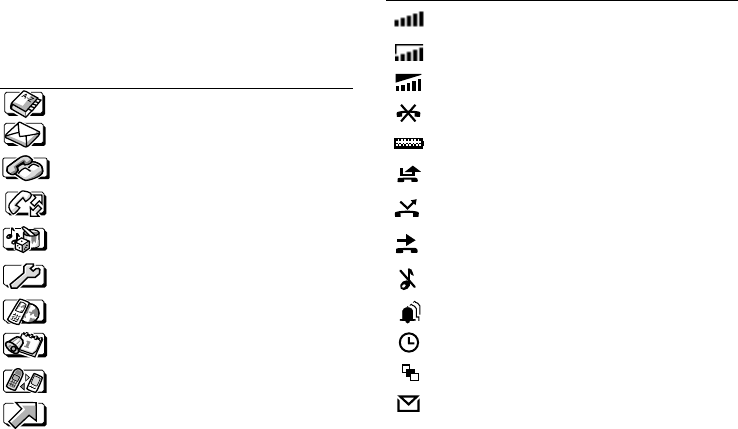
87 Icons
Icons
The table below shows icons which may appear in
standby or in the menus.
Icon Description
Your personal phone book.
Handling of text and voice messages.
Handling of call time, call cost information
and ongoing calls.
Handling of ongoing calls. Only available
during calls.
Handling of pictures, sounds and themes. Play
games.
Personal settings, profiles, divert calls,
networks and voice control.
Gives you access to WAP services on the
Internet.
Calendar, notes, alarm clock and other extras.
Bluetooth function, synchronization, infrared
port.
Create your own menu for the functions you
use most often.
Tells you the strength of the GSM network
signal.
GPRS is within range.
GPRS is within range and can be used.
You cannot receive any incoming calls.
Tells you the status of the battery.
You have missed an incoming call.
All incoming calls are diverted to a defined
number.
No calls or only certain calls from numbers in
a list are received.
All signals are turned off, except the alarm and
timer.
The alarm clock has been set and is on.
The timer has been set and is on.
A profile other than Normal has been chosen.
You have received a text message.
Icon Description
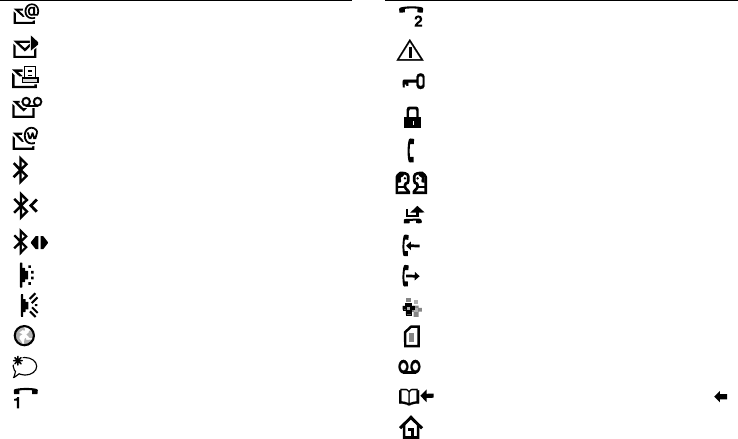
Icons 88
You have received an e-mail message.
You have received a multimedia message.
You have received a fax message.
You have received a voice message.
You have received a WAP push message.
The Bluetooth function is on.
The Bluetooth function is in discoverable
mode.
Bluetooth communication is in progress.
The infrared port is on.
Infrared communication is in progress.
A GPRS session is in progress.
The magic word is turned on.
Line 1 is in use for outgoing calls.
Icon Description
Line 2 is in use for outgoing calls.
Ciphering is currently not being provided by
the network.
The keypad is locked.
The card lock or phone lock is on.
A secure WAP connection is established.
An ongoing call.
A chat session is in progress.
A missed call in the call list.
An answered call in the call list.
A dialled number in the call list.
A group of contacts in the phone book.
A text message is saved on the SIM card.
A voice message has not been checked.
You can enter the phone book by pressing .
A home number in the phone book.
Icon Description
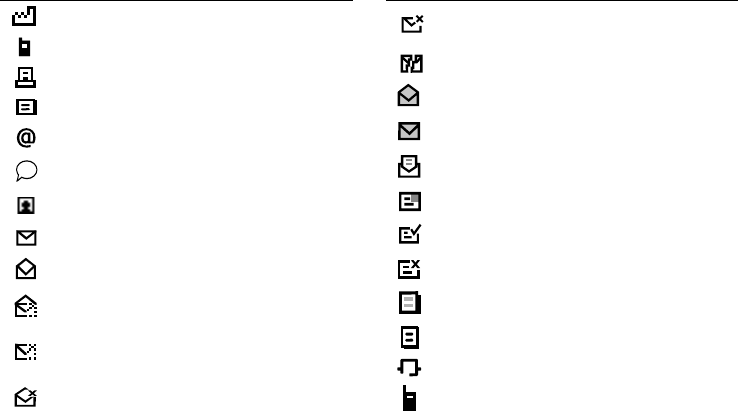
89 Icons
A work number in the phone book.
A mobile number in the phone book.
A fax number in the phone book.
Another number in the phone book.
An e-mail address in the phone book.
A voice command has been recorded for a
contact name.
A picture is connected to the contact.
A message has not been read.
A message has been read.
Only part of a read e-mail or a multimedia
message is saved in the phone.
Only part of an unread e-mail or a multimedia
message is saved in the phone.
A read message will be deleted the next time
you connect to the server.
Icon Description
An unread message will be deleted the next
time you connect to the server.
A damaged message.
A read Nokia picture message. Nokia is a
registered trademark of Nokia Corporation, Finland.
An unread Nokia picture message.
The message has not been sent.
The message has been sent.
A message has been delivered or read by the
recipient.
A sent message that has expired or been
rejected by the recipient.
Pre-defined message template (not editable).
User-defined message template.
A Bluetooth headset, paired with your phone.
A Bluetooth phone, paired with your phone.
Icon Description
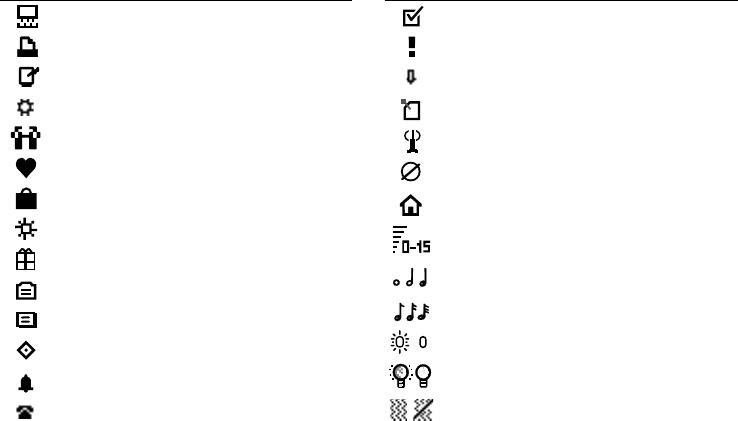
Icons 90
A Bluetooth PC, paired with your phone.
A Bluetooth printer, paired with your phone.
A Bluetooth PDA, paired with your phone.
Other Bluetooth device.
The appointment is a meeting.
The appointment is a date.
The appointment is to travel.
The appointment is a vacation.
The appointment is an anniversary.
A miscellaneous appointment.
A miscellaneous task.
An all day calendar appointment.
A reminder is set for a calendar appointment.
The task is a phone call.
Icon Description
A completed task in your calendar.
A task or message of high priority.
A task or message of low priority.
The note is displayed in standby.
The network is preferred and can be used.
The network is forbidden and cannot be used.
Your home network is within range and can be
used.
A volume between 0 and 15 has been selected.
Whole note, half note, 1/4 note.
1/8 note, 1/16 note, 1/32 note.
Turns the indicator light on and off.
Turns backlight on and off.
Turns vibrating alert on and off.
Icon Description
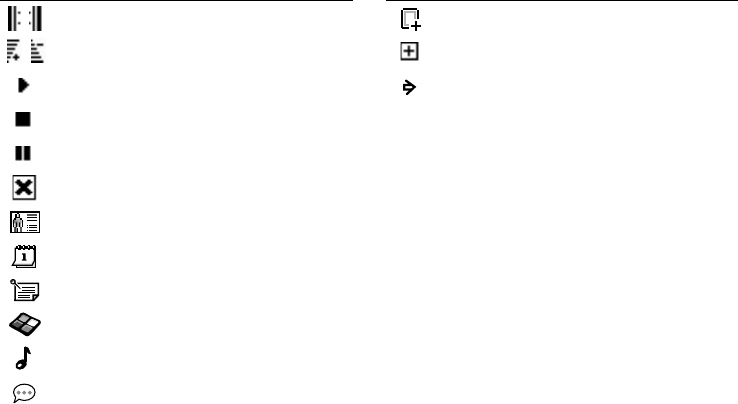
91 Icons
Starts and stops a melody loop.
Increases and decreases the volume one step.
A multimedia message is playing.
A multimedia message has been stopped.
A multimedia message has been paused.
Picture could not be shown.
A business card is attached to a multimedia
message.
A calendar item is attached to a multimedia
message.
A note is attached to a multimedia message.
A theme is attached to a multimedia message.
A multimedia message contains a melody.
A multimedia message contains a recorded
sound.
Icon Description
Cursor in a multimedia message.
More message options.
Chat message prompt.
Icon Description